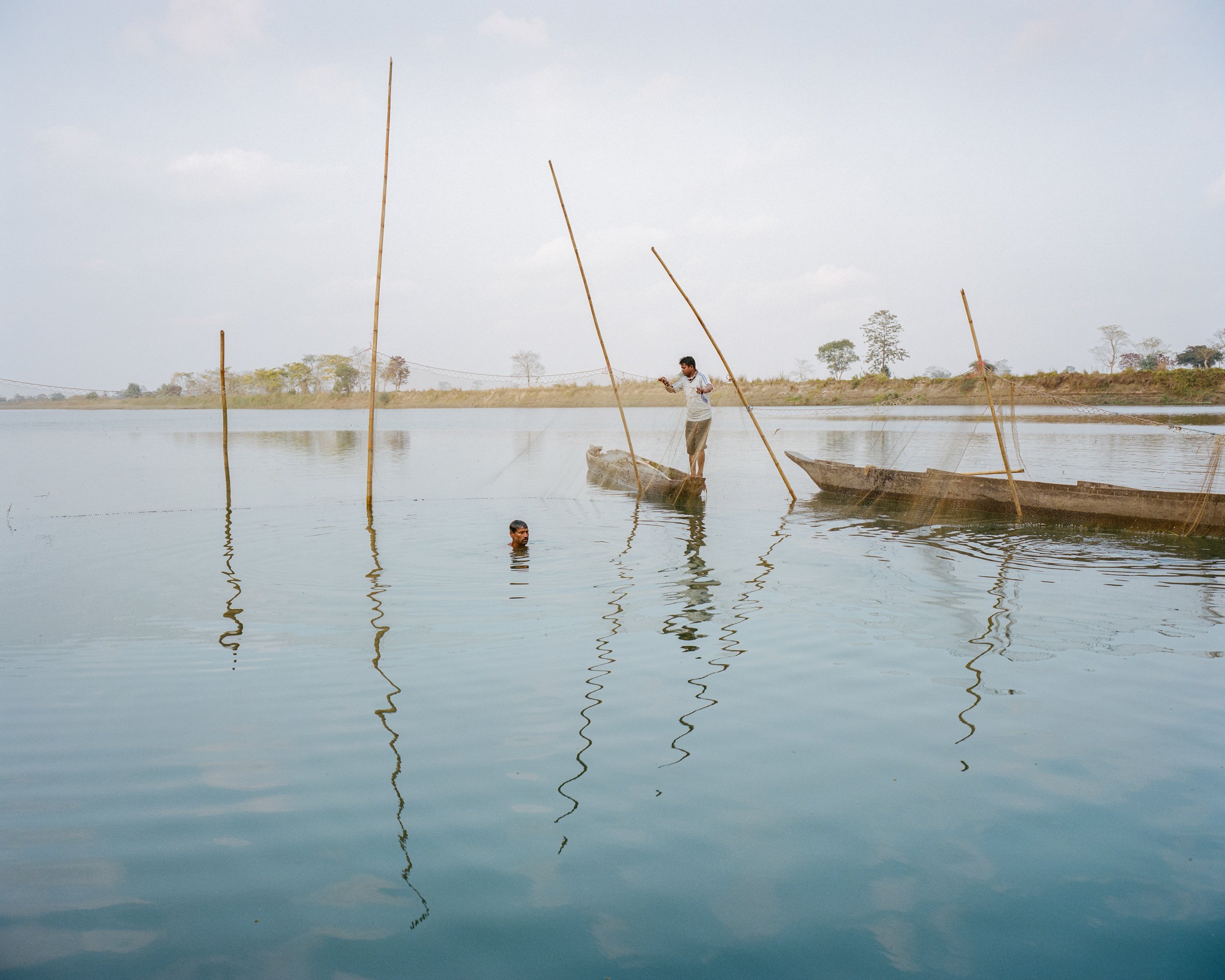
During my journey to India I met Brahmaputra, the son of God, the last great free- flowing river with a spirit and reverence.
In the eternal view of his floodplains, in the relentless flow of his stream, and in the people who respect and honour him, I was witness to a childhood memory I never got to know. All the missing elements from my childhood has been completed by the experiences I collected on the bank of this mighty river. ‘You can flood me, I’ll be here’ is an exploration of my encounter with a sensitive, harmonious, yet defenceless relationship of people with nature and water on the island of Majuli. My motivation is to photograph the issues of isolation in physical, social, and spiritual sense, and focusing on how people react to the river and interact with the ever-changing environment.
Men fish with a fenced trap called the ‚Jang’ on the Kherkata River, which is one of the inner branches of Brahmaputra and separates the island from the mainland on the north side. The families of the village come together and do the hard physical work and then share the fish from the net.
Jengraimukh, Majuli, India — 2020
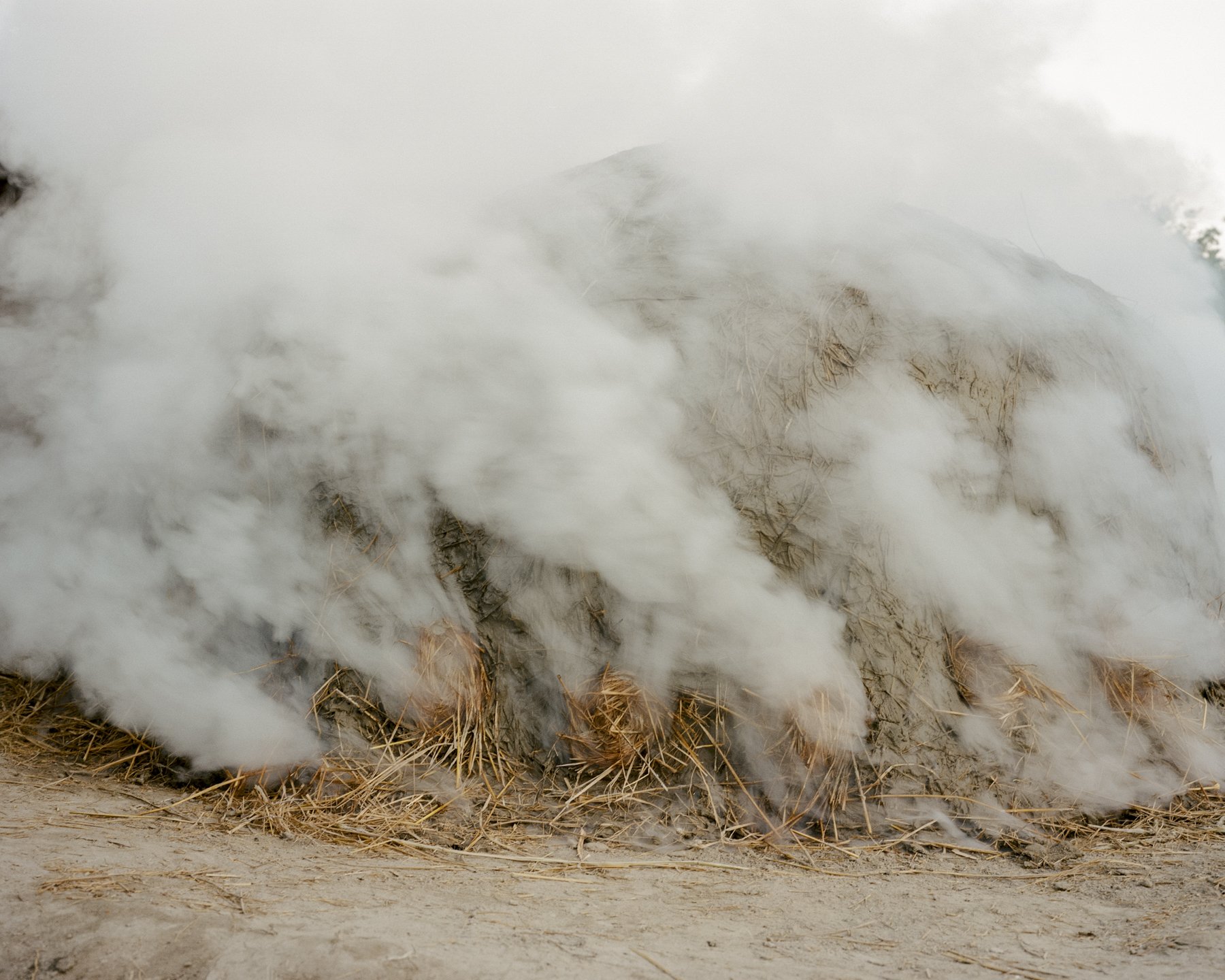
Majuli is the largest river island in the world, located on the majestic Brahmaputra River that winds through the state of Assam in Northeast India. The history of the island and identity of people living there have been defined for centuries by the flooding presence of the river that actively shapes not only its territory, but fates. The sensitive, harmonious, yet defenseless relationship of people with nature and water manifests itself in dystopian everyday life. Their homes, safety of their families, crops and fished food, in fact, their simple existence, are all subject to the constant changes of the river and its environment. People have learned to live in balance and adapt to change over time. It has been accepted that the river is always lost or given. However, global environmental changes of our time have upset the balance: in the last few decades the island area has shrunk by a third due to increasing soil erosion forcing thousands of families to flee their homes, monsoons are no longer arriving at the usual time (or not at all), water pollution is increasing and floods have become more unpredictable.
Carefully stacked clay pots are patched with mud and straw and then fired all day long. Every little detail is significant: the fire laid out of the driftwood, the clay dug out of the riverbed and the construction of the dome are also a gesture towards nature.
Salmora, Majuli, India — 2021
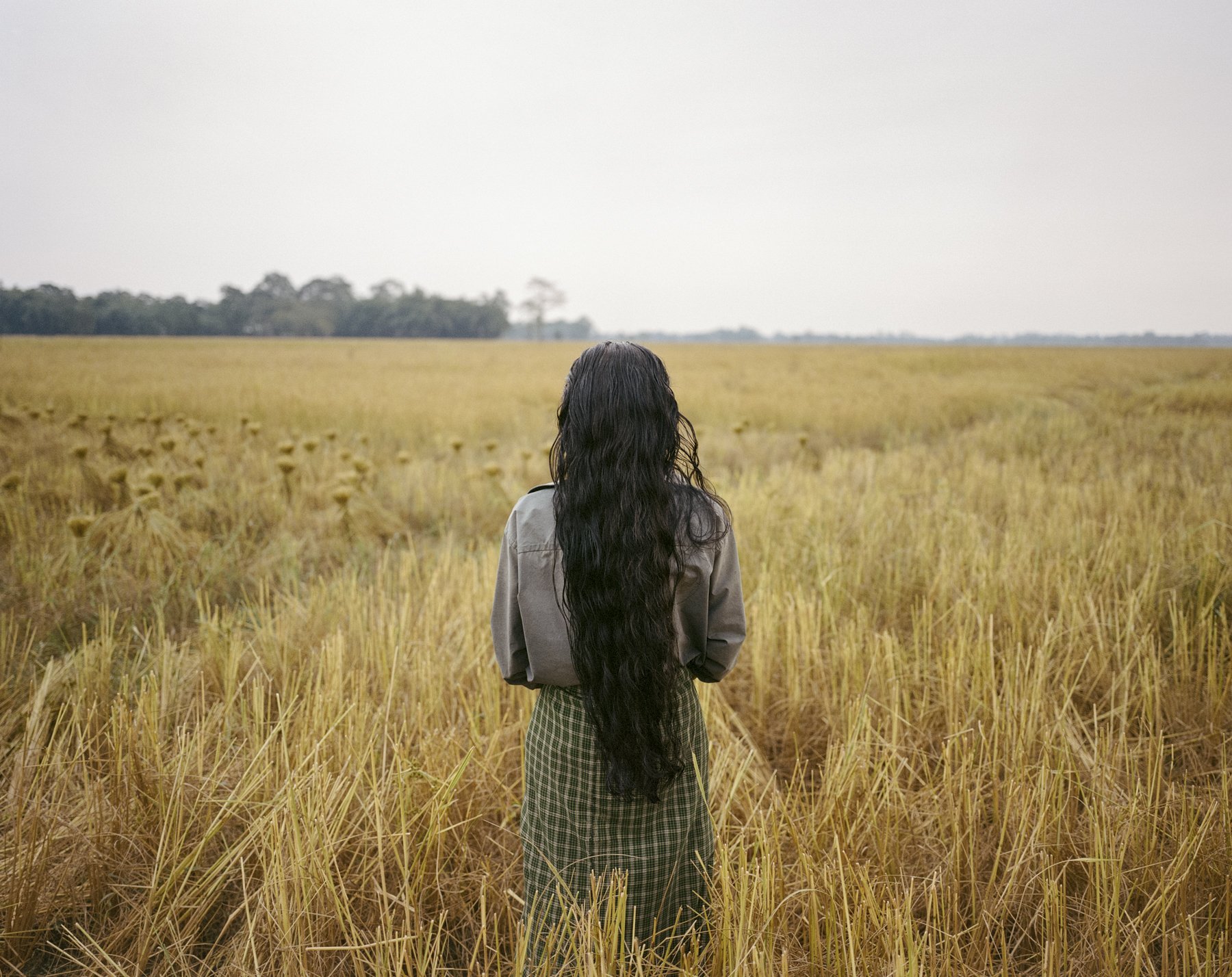
I realized that the locals’ interpretation of the problem is completely different from what an outside observer might think at first. My main motivation and the reason why I am doing this project is to find a sensitive, unique narrative of climate change that does not dehumanize this issue by showing the sensational, but rather enhances the human aspect of the problem. I am interested in photographing the issues of Majuli’s isolation in physical, social, and spiritual sense, and fo- cusing on how families (I personally know) react to the river and interact with the ever-changing environment. Since 2020, I have visited the island 3 times so far, and would like to continue the story.
This is an ongoing project that has been supported by Carmencita—KODAK Grant, and the József Pécsi Photography Scholarship (Hungarian Cultural Fund).
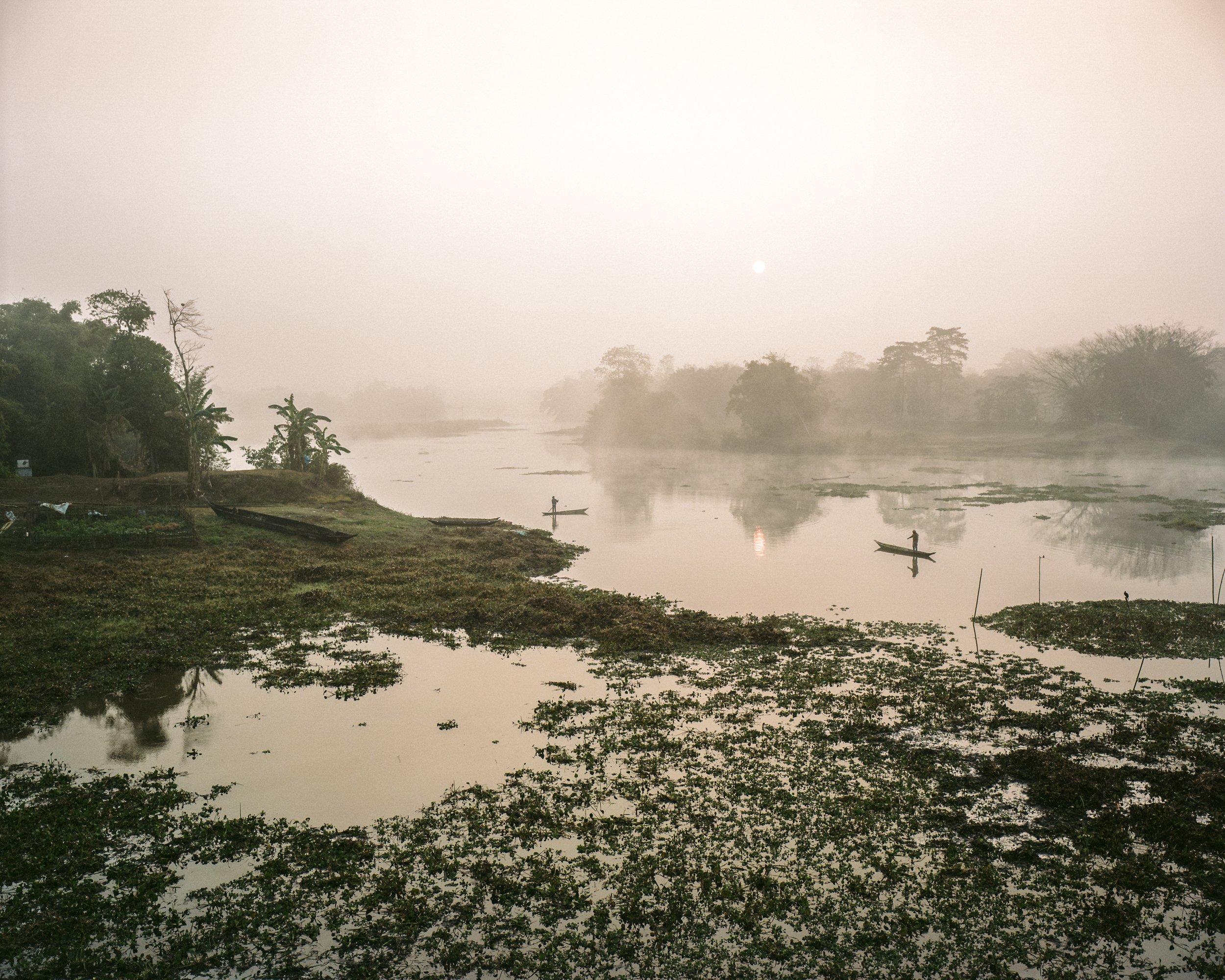
Morning view of inland swamp lakes in Majuli between the two biggest village Gara- mur and Kamalabari. Humans and environment have been in dynamic relationship on the island for a long time ago. People adapted to the river’s annual rhythm, though, the ecological balance seems to be upset recently making flood-vulnerable lands
Kamalabari, Majuli, India — 2020
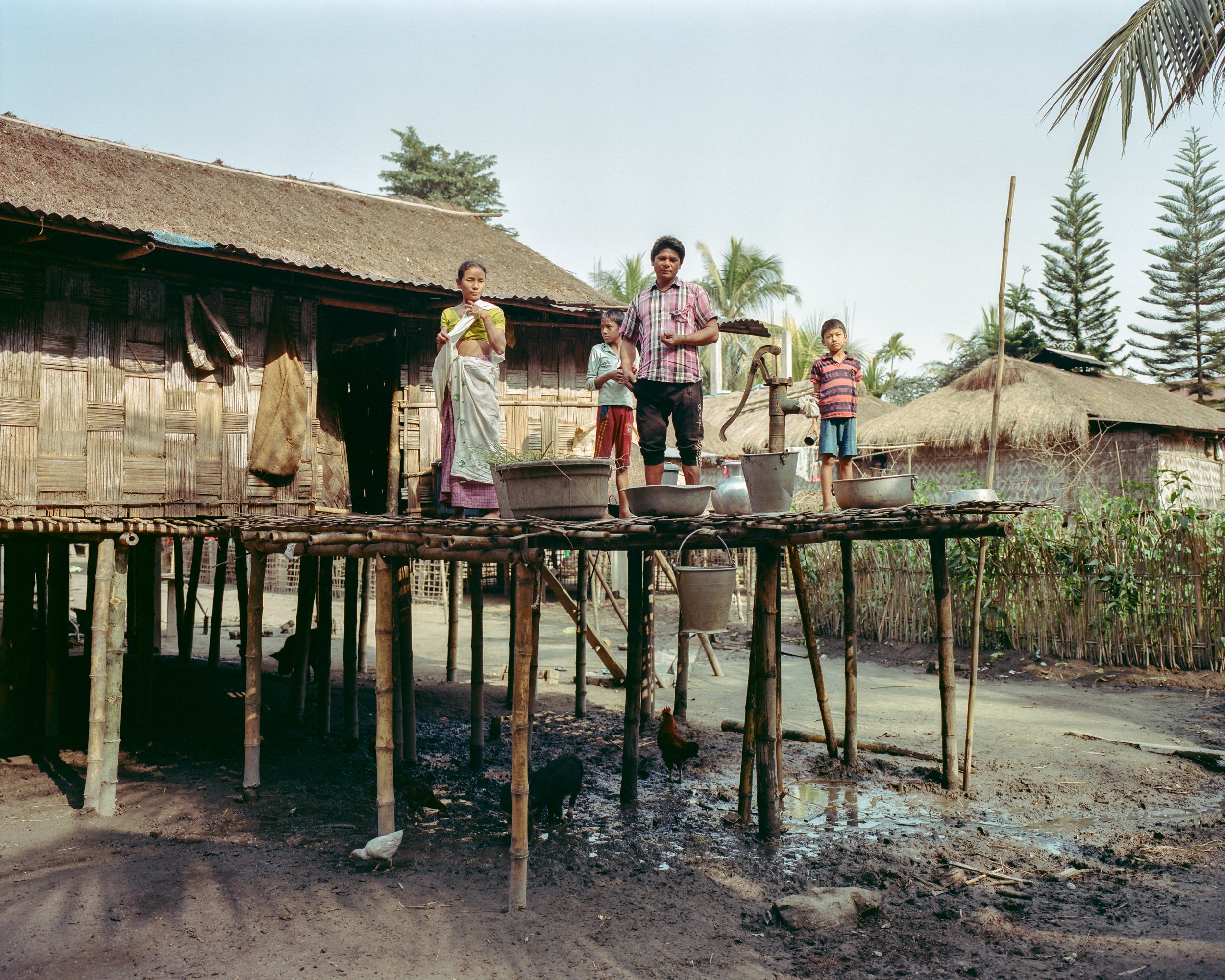
Traditionally built bamboo houses protect locals from rising water level during floods. The members of the indigenous tribes adapted to the extremely unpredictable river in this way.
Karatipar, Majuli, India — 2020
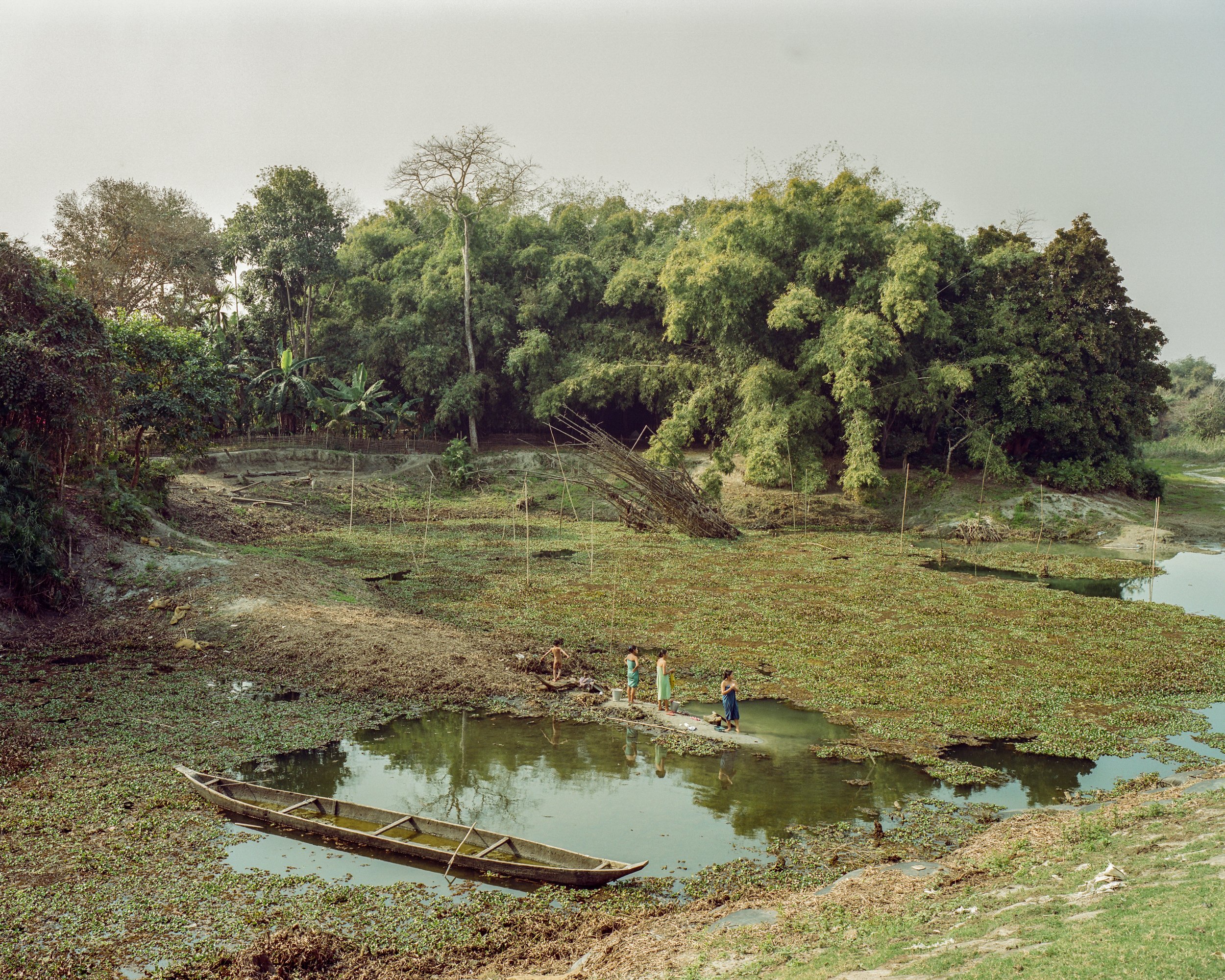
Islanders are accustomed to the constant presence of water, which determines their identity. As a significant part of the island is practically floodplain, roads and larger settlements were built on or along dams. Flooded lands are used differently each season.
Karatipar, Majuli, India — 2020
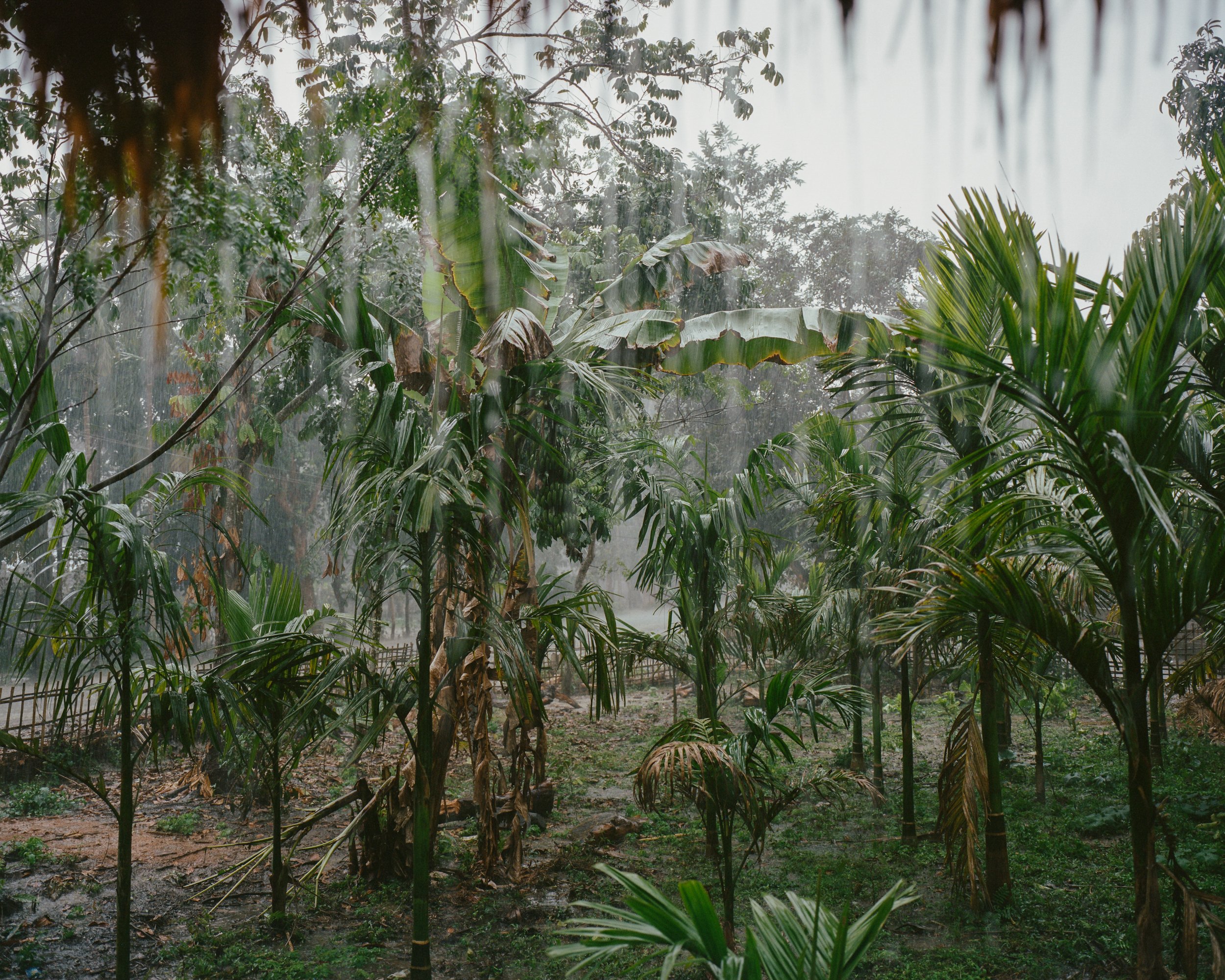
Rain is one of the most important forces shaping the island that locals see as a divine blessing and await the arrival of the monsoon to fill their paddy fields with water. However, the amount of precipitation also swells the Brahmaputra and makes it dangerous during summer.
Recently, the cycles of monsoon are no longer arriving at the usual pace which also makes cultivating more difficult. People must face and adapt somehow to irregular climatic changes.
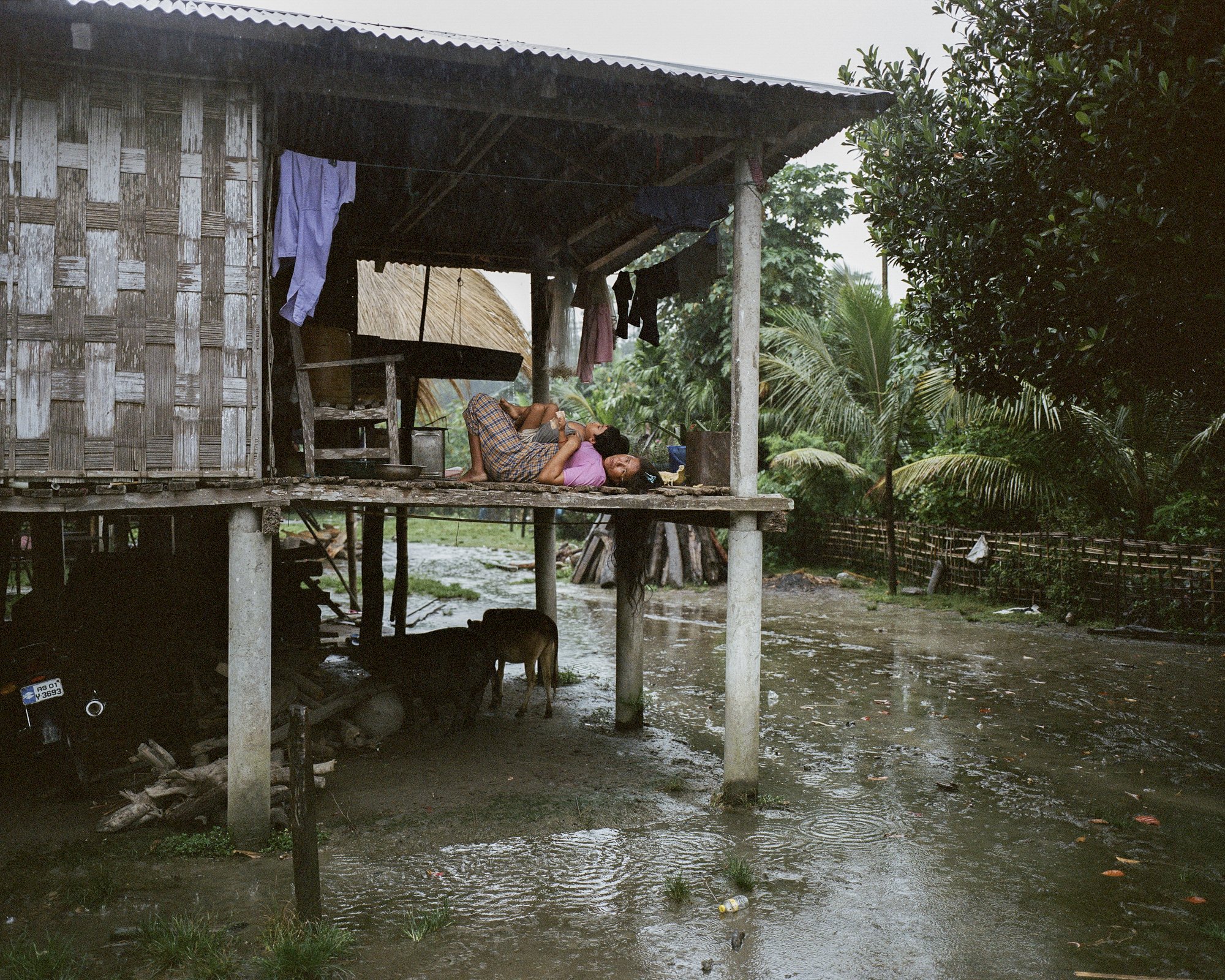
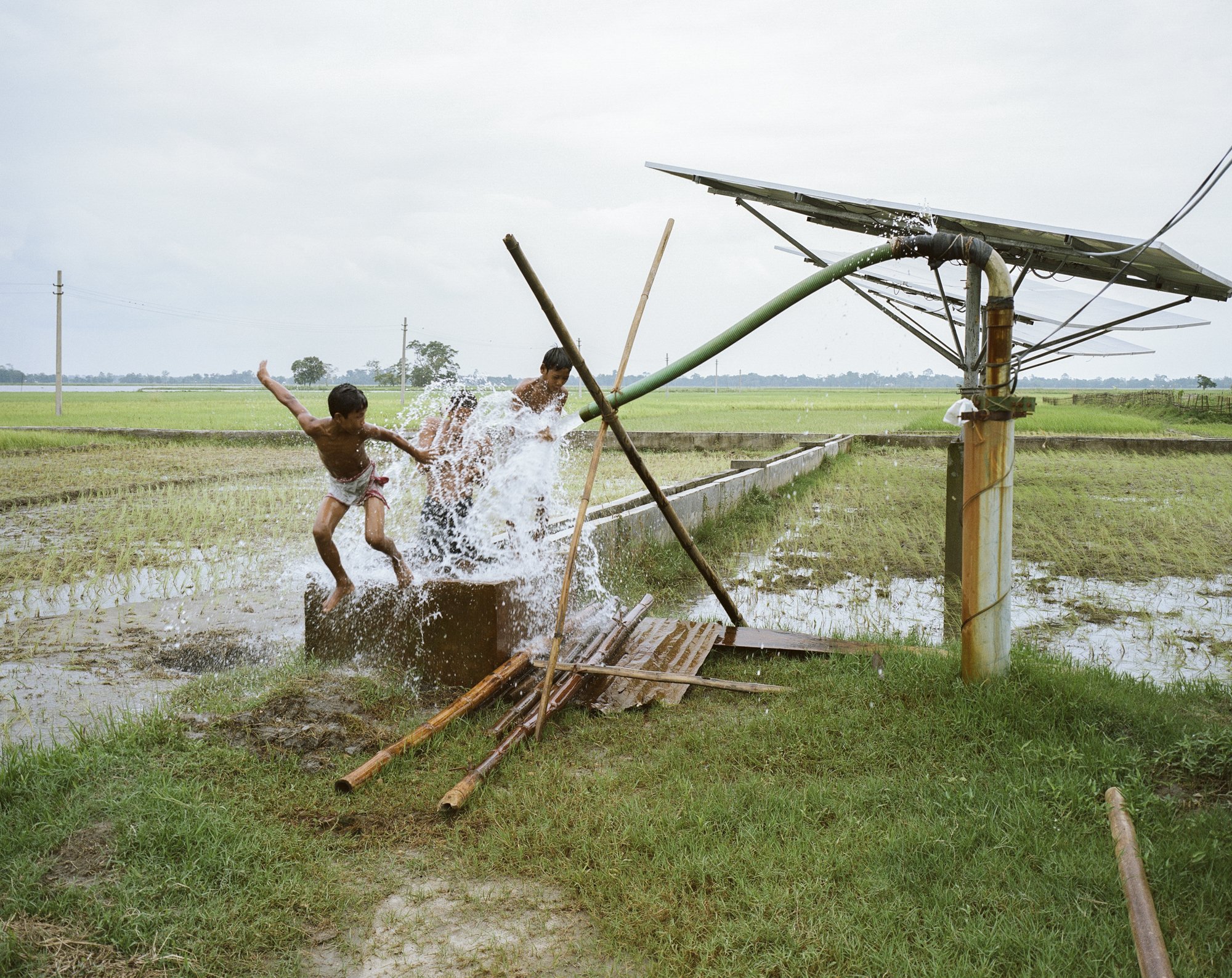
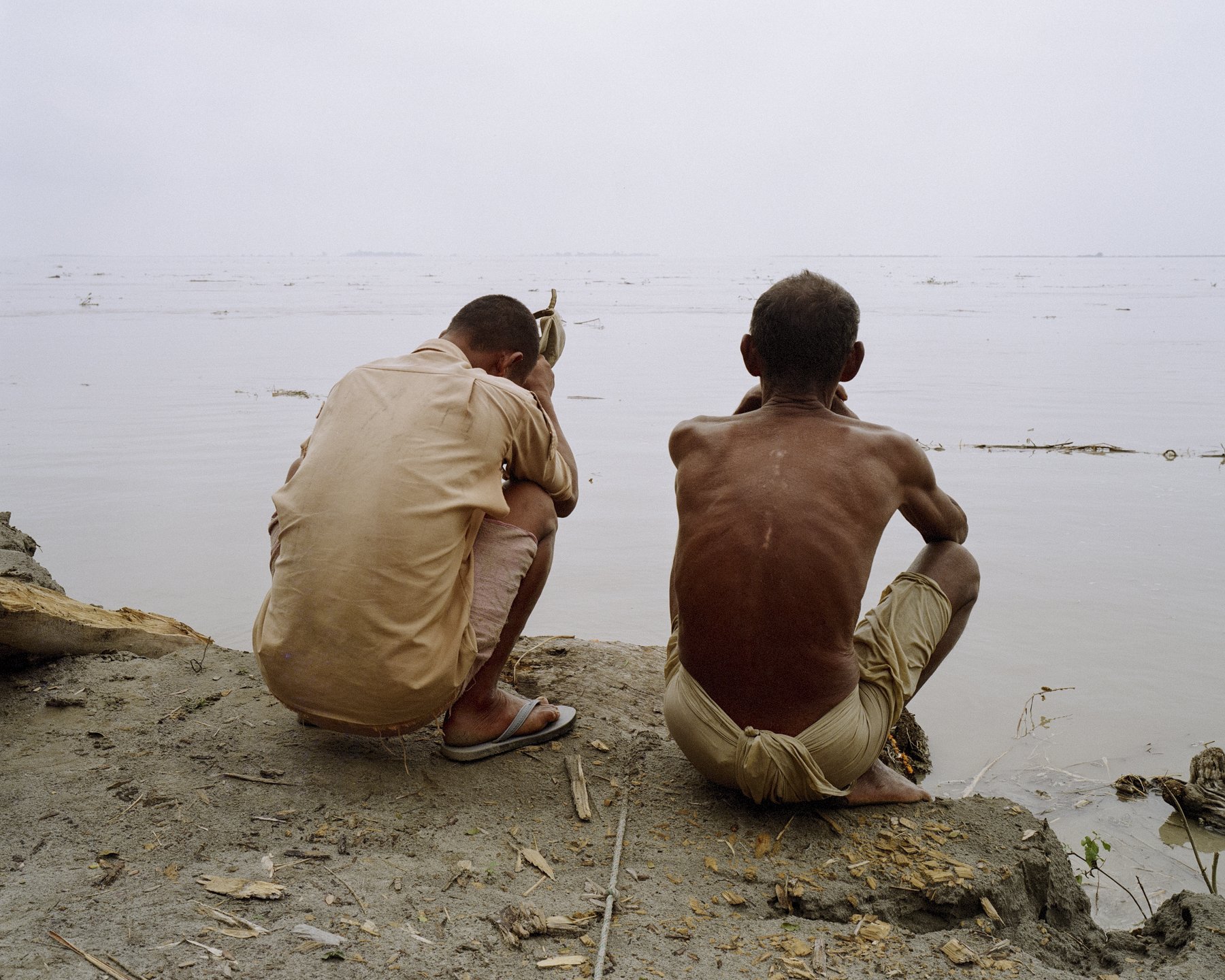
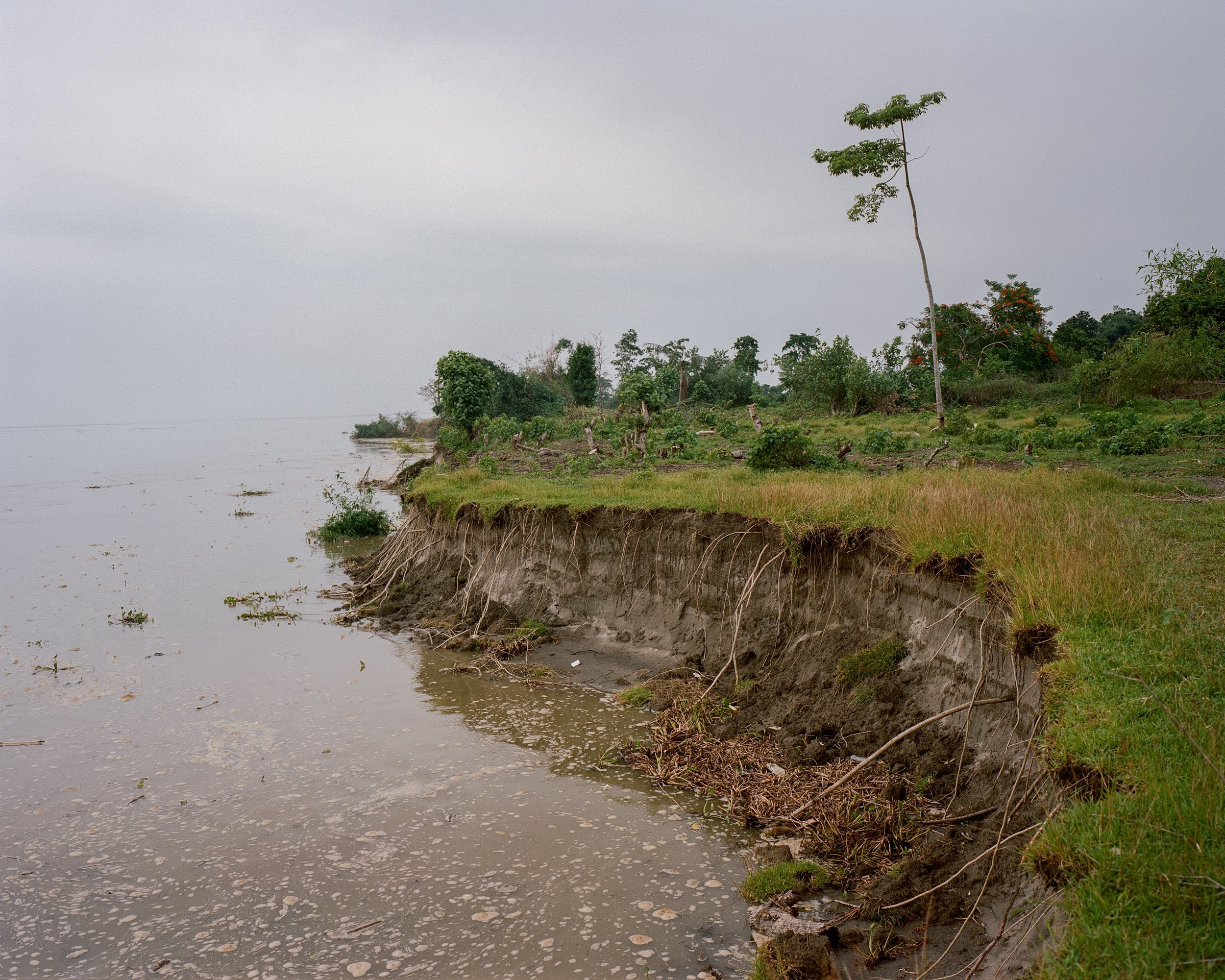
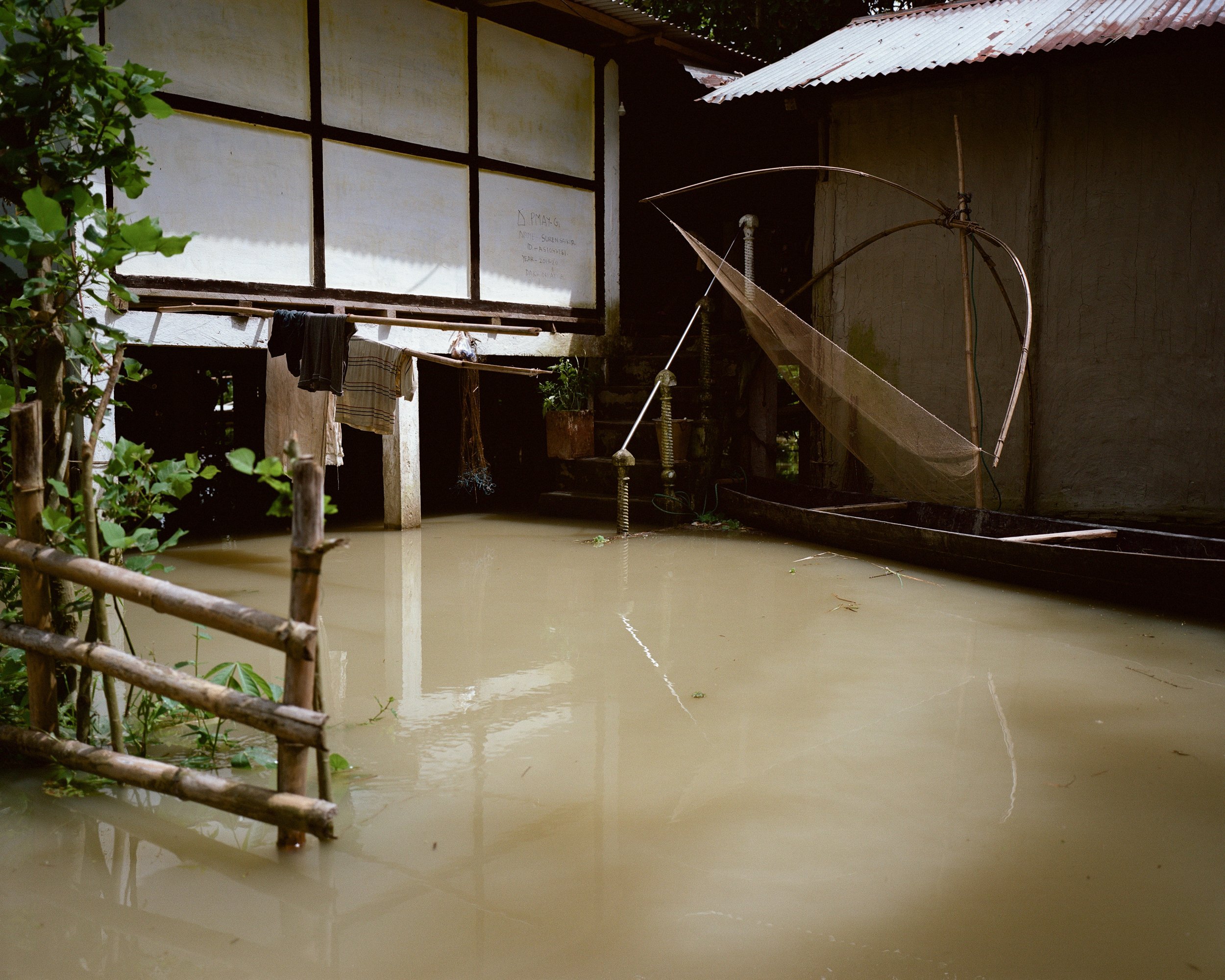
Salmora is one of the most affected village all around Majuli. People are used to the constantly flooding river. When dangerous flood and erosion come, people give up their previous home and move forward, if it is possible. Since the island is shrinking, the less place left for those who need a new place to live. This house is built by government aid, however, the new owners has to be prepared for a possible move in the near future.
Salmora, Majuli, India — 2021
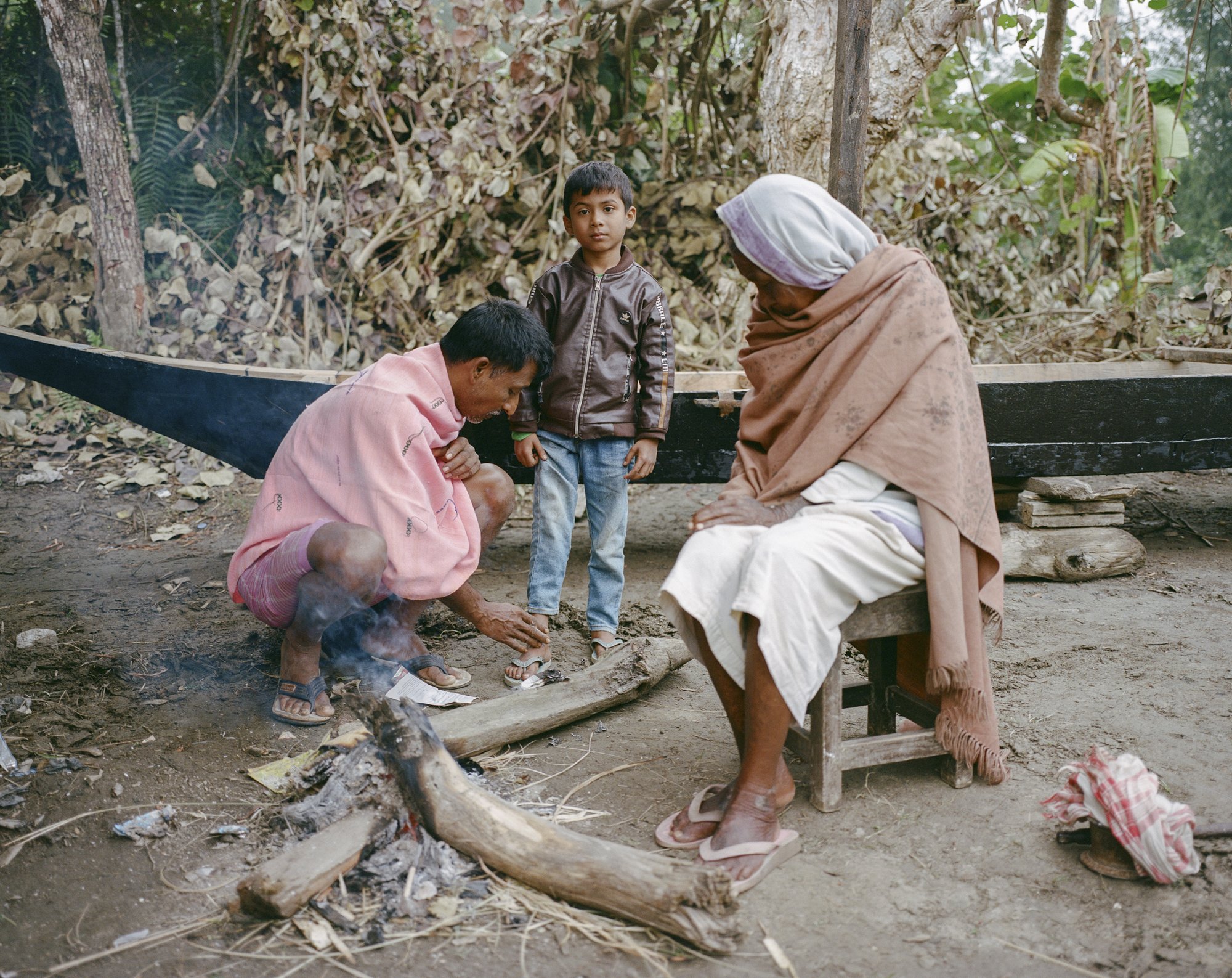

It had to wait longer than usual until the first heavy rainfall during last year’s monsoon. This climate anomaly has posed new types of challenges to farmers and livestock keepers. According to locals,, they have never experienced so little rainfall as they did this summer. The sudden blessing of heaven also surprised a flock of sheep who took refuge on the terrace of a school.
Takarchuk, Majuli, India — 2021
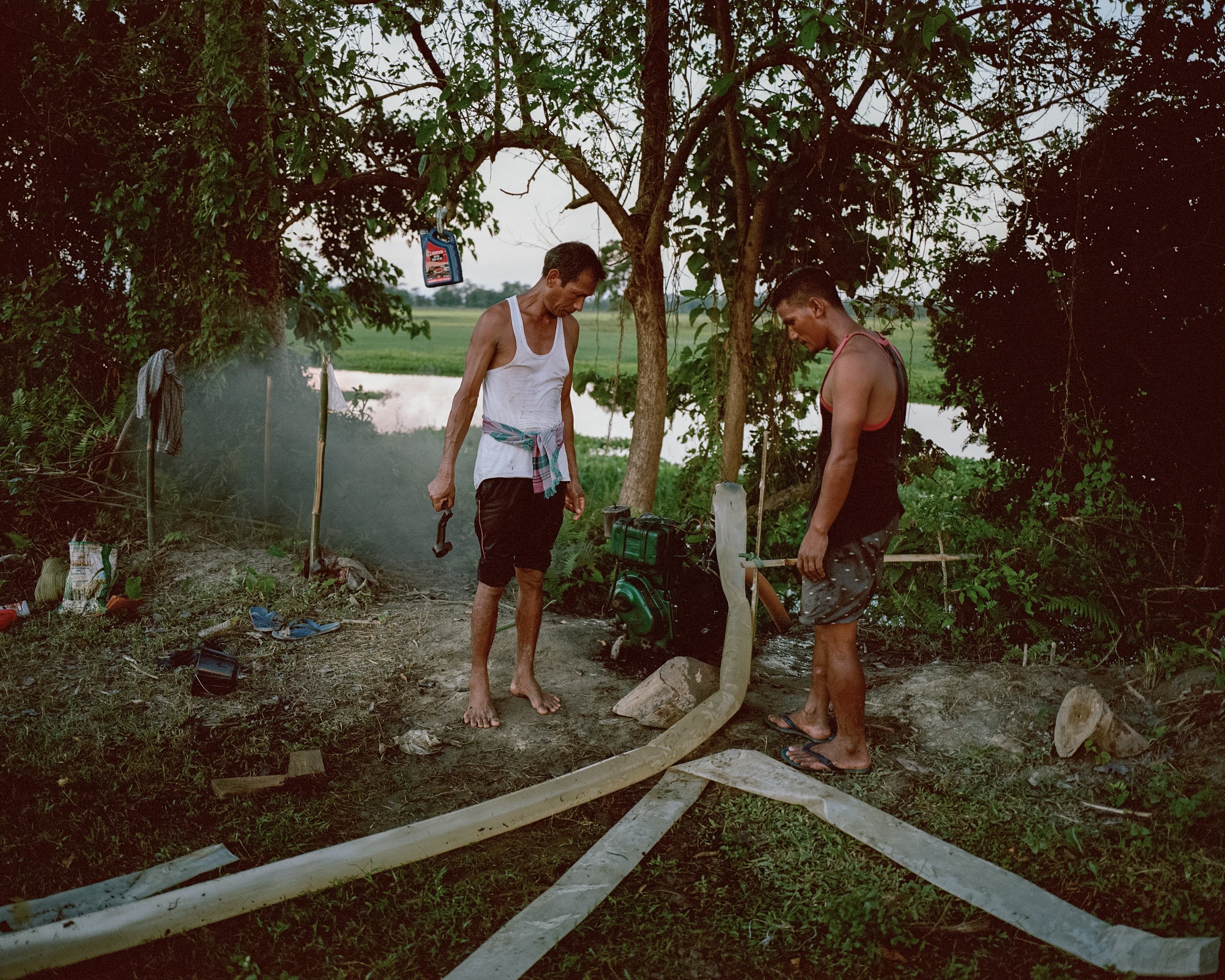
Farmers have to deal with drought through alternative methods. The annual crop should not be endangered, so in the absence of rain, they try to pump water on the freshly planted paddy field.
Kumar Bari, Majuli, India — 2021
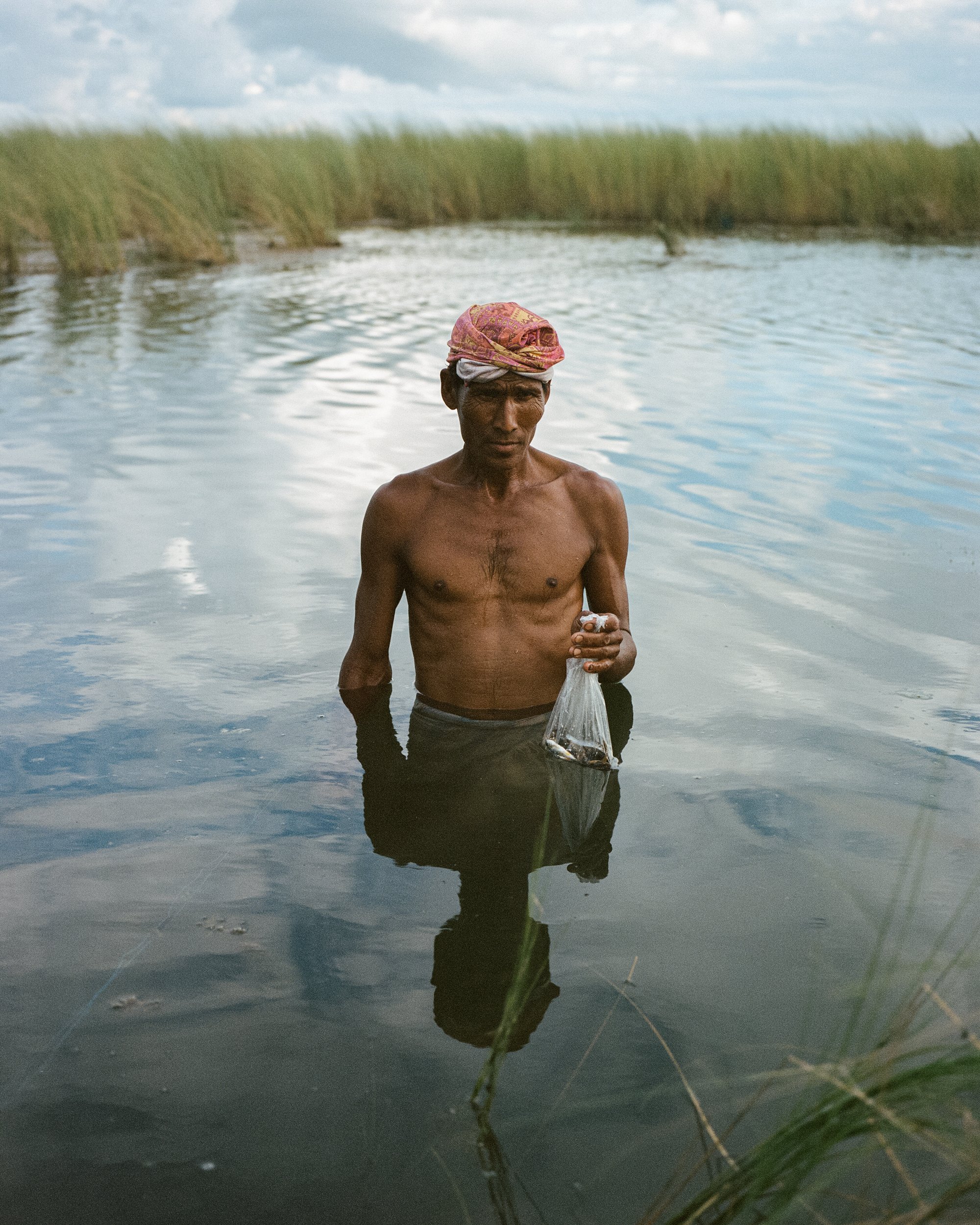
Minol is a fisherman. He has been living on different chaporis from childhood. Chaporis are temporary sand islands that are shaped by sediments. Minol eve- ryday goes to fish and lives a simple life of river people. He is not willing to move away from the river.
Sumoi Mari Chapori, Majuli, India — 2021
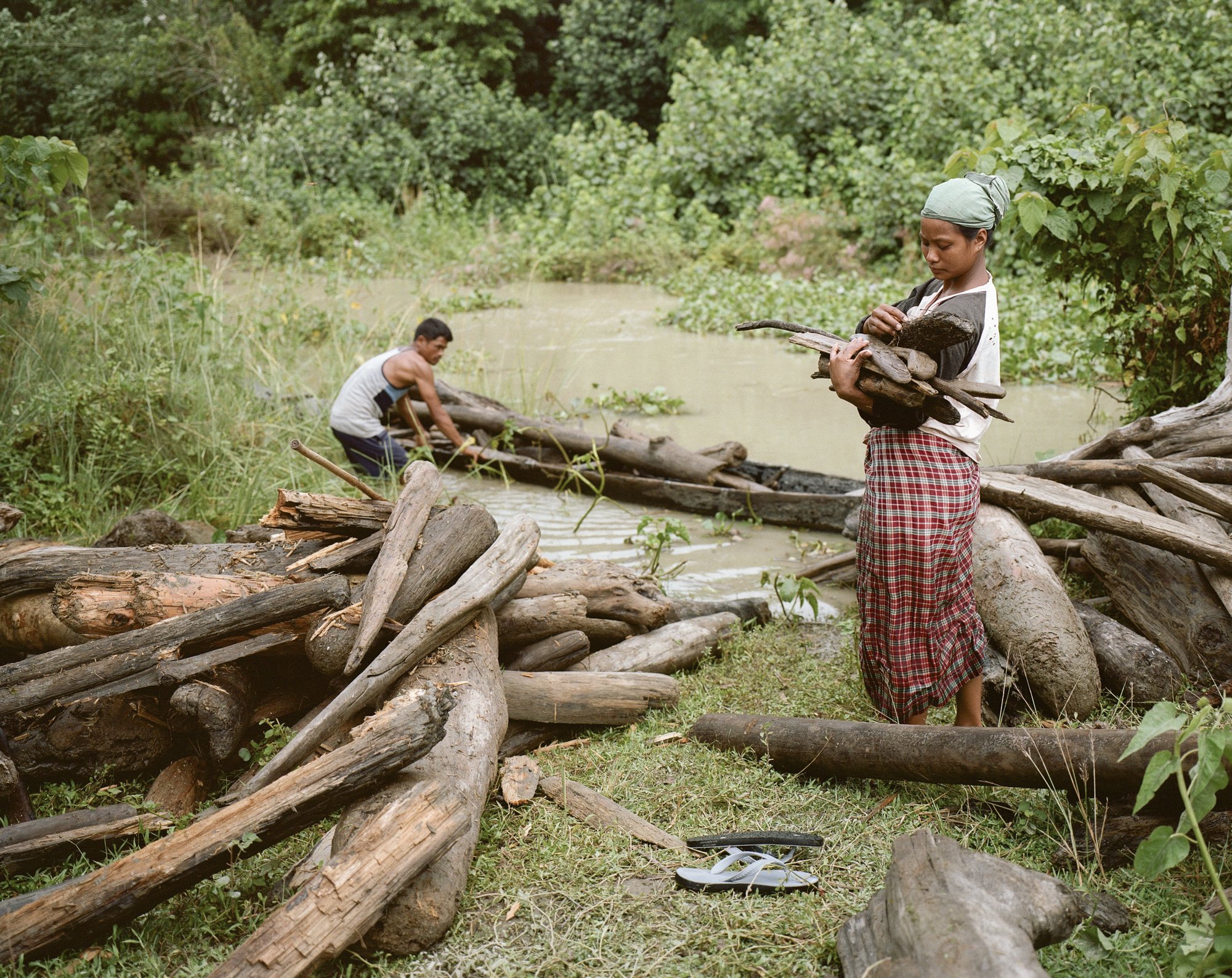
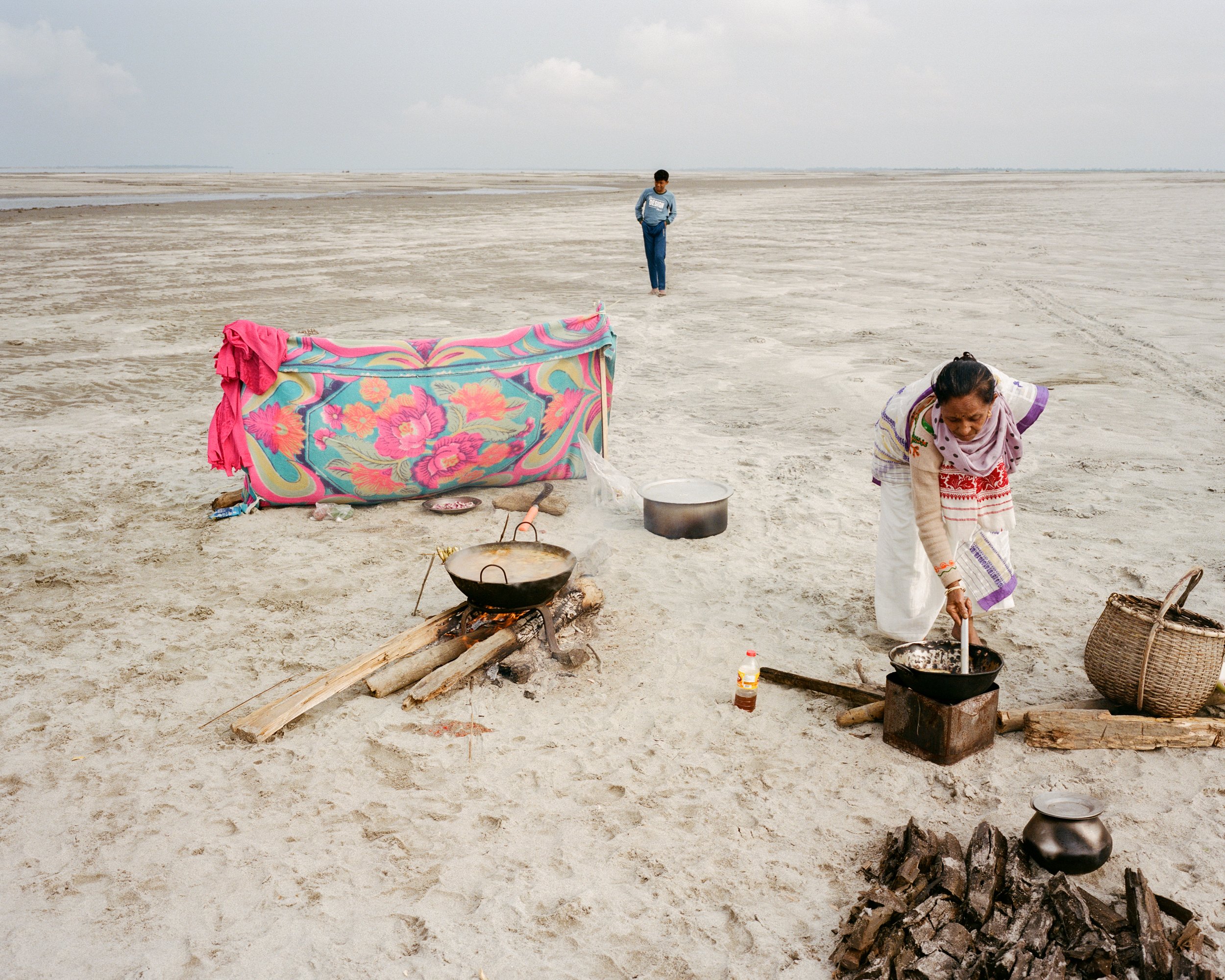
Arima Das is cooking a festive lunch on a newly built sand island for his family and friends. After the morning fishing, they spend a full day together: praying for the abundance of fish to the gods of the river, eating rice, drinking tea and buffalo milk on the fine-grained sand in the Brahmaputra riverbed.
Salmora Chapori, Majuli, India — 2021
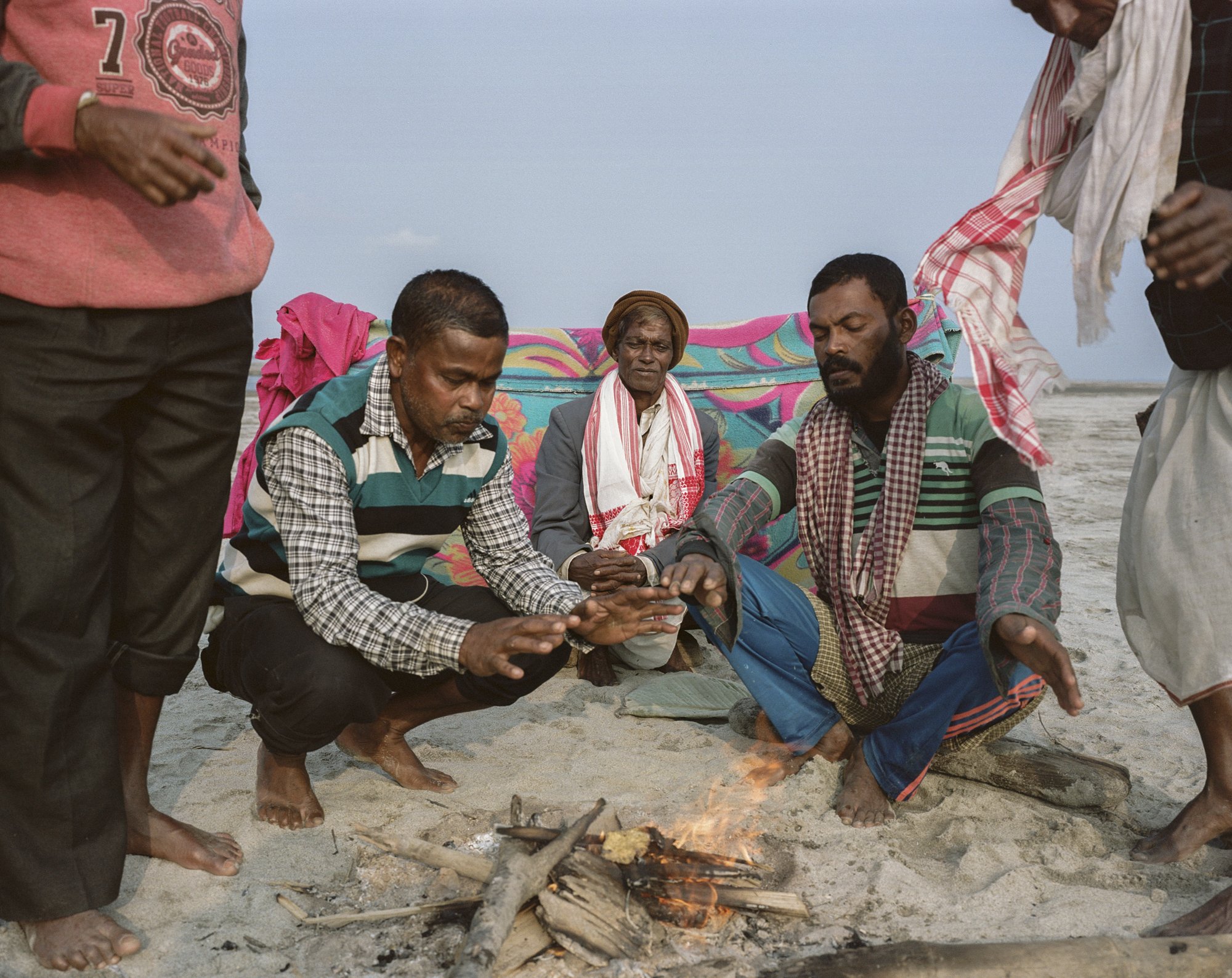
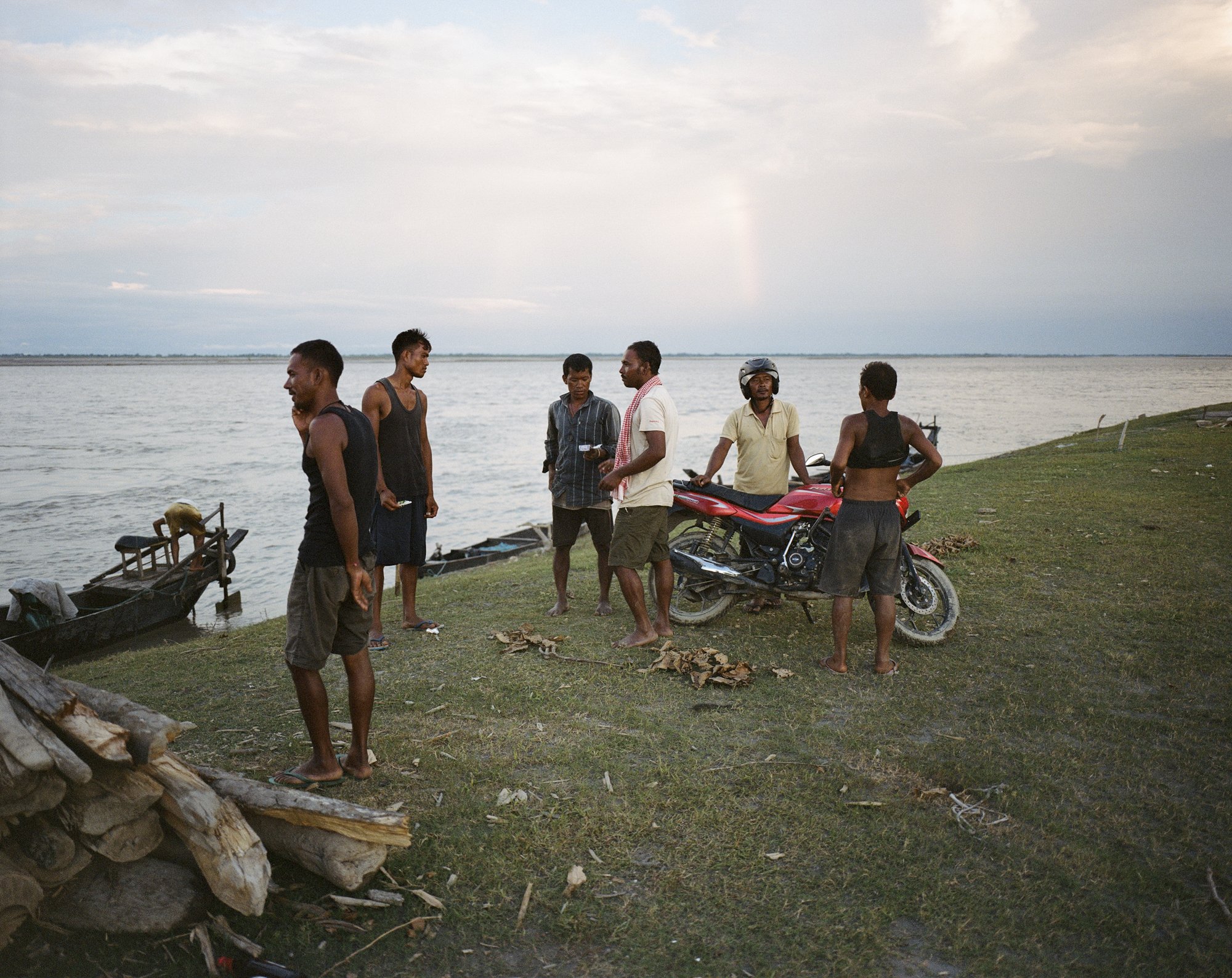

Fallen banana trees mark the trail of a new asphalt road near Phuloni. The new state president of Assam is implementing a huge infrastructure development on the island. The most significant of these is the nearly 5 km long bridge, which could completely change the island’s environment and current calm life.
Phuloni, Majuli, India — 2021
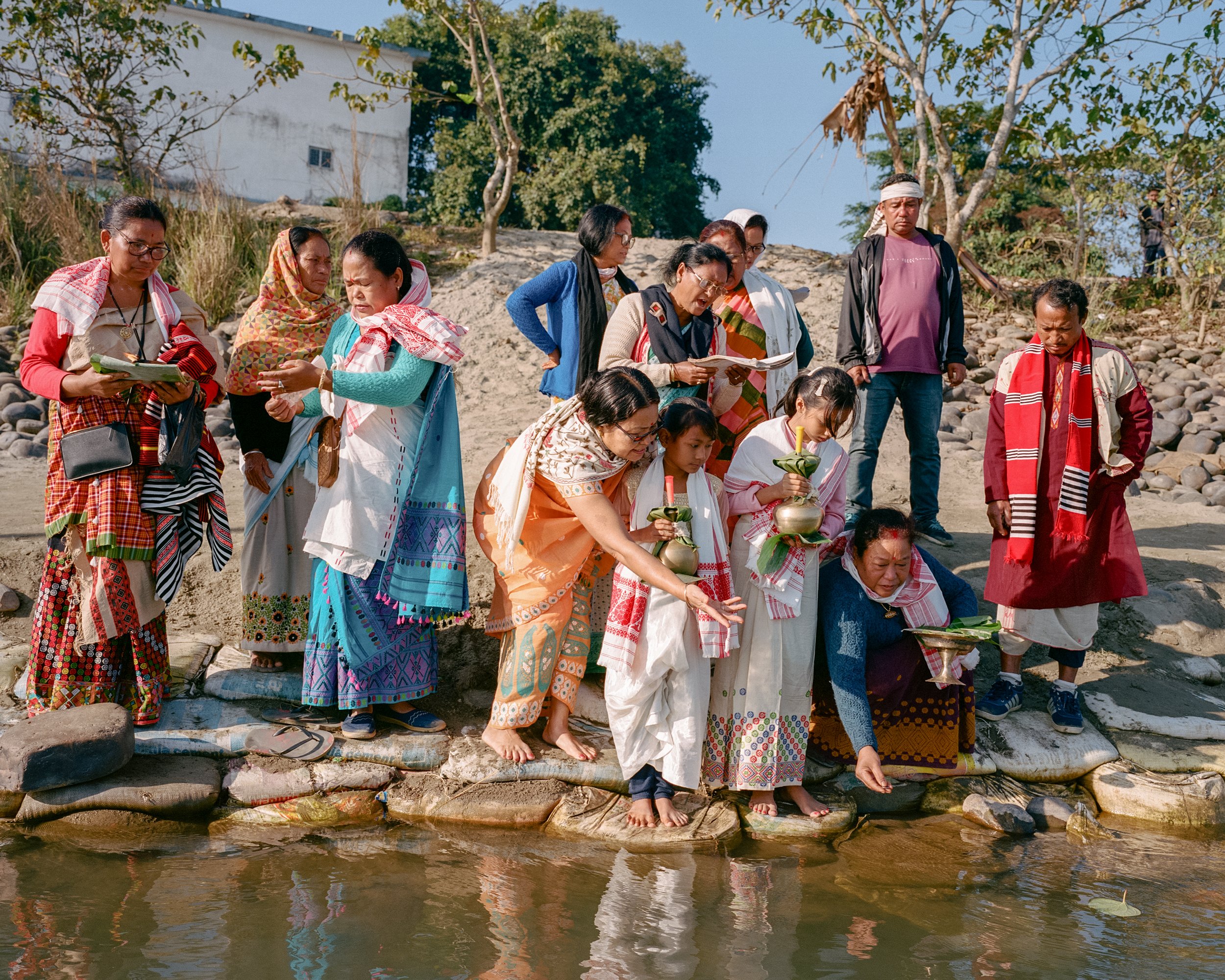
A Mising family holding a tribal ritual and collecting water from the river Kherkata which is a small offshoot of Brahmaputra. This narrow river flows west and south- west direction demarcating the northern boundary of Majuli. The holy water will be used for a wedding ritual where the mother will wash and bless the groom with the river water. People on the island are very close to the river spiritually.
Jengraimukh, Majuli, India — 2021
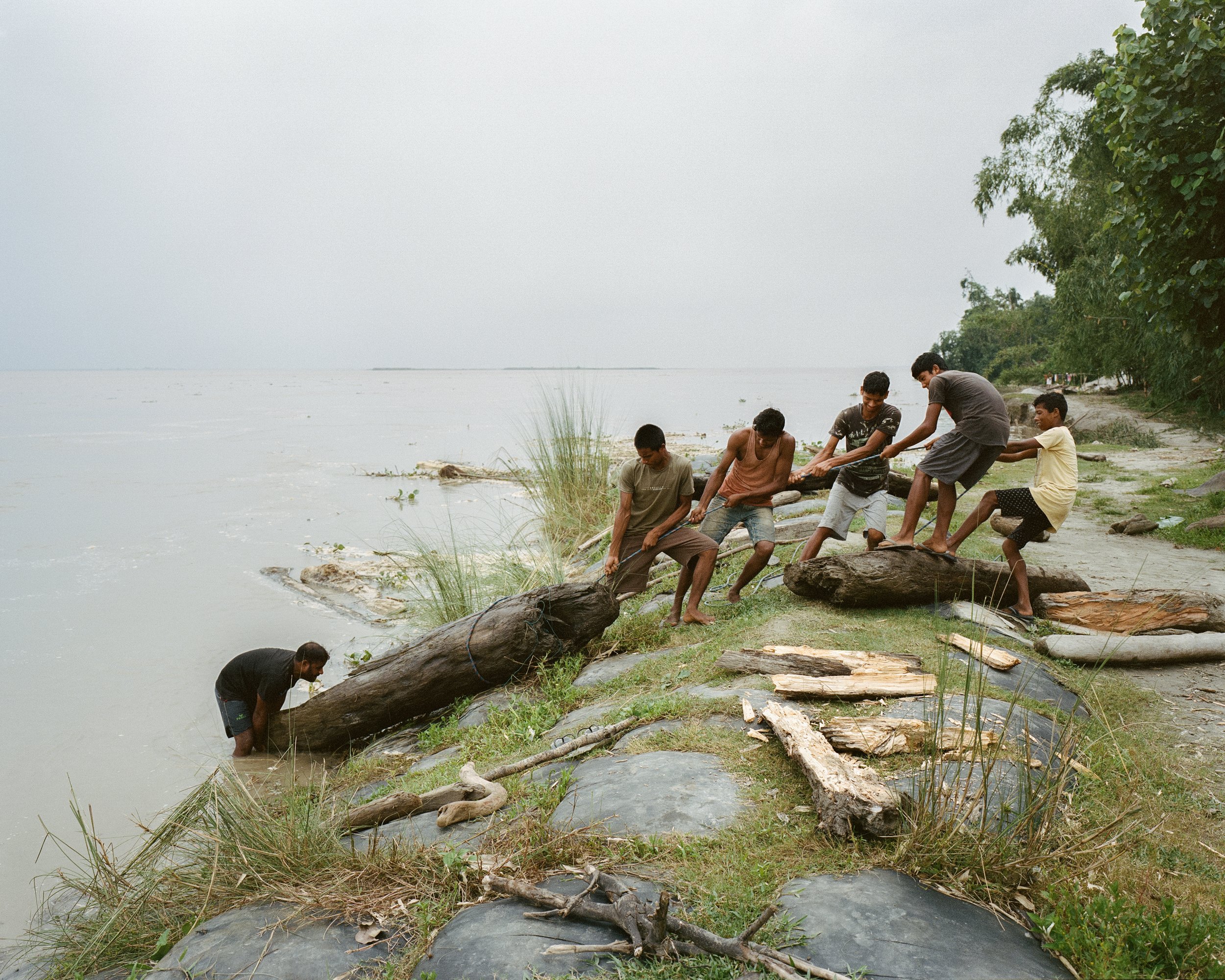
The only income during the monsoon season is to catch huge logs that can be sold later on. Villagers helping to pull out a hundreds of kgs piece from the Brahmaputra. After drying and chopping them they can sell for a decent price.
Ahato Guri, Majuli, India — 2021
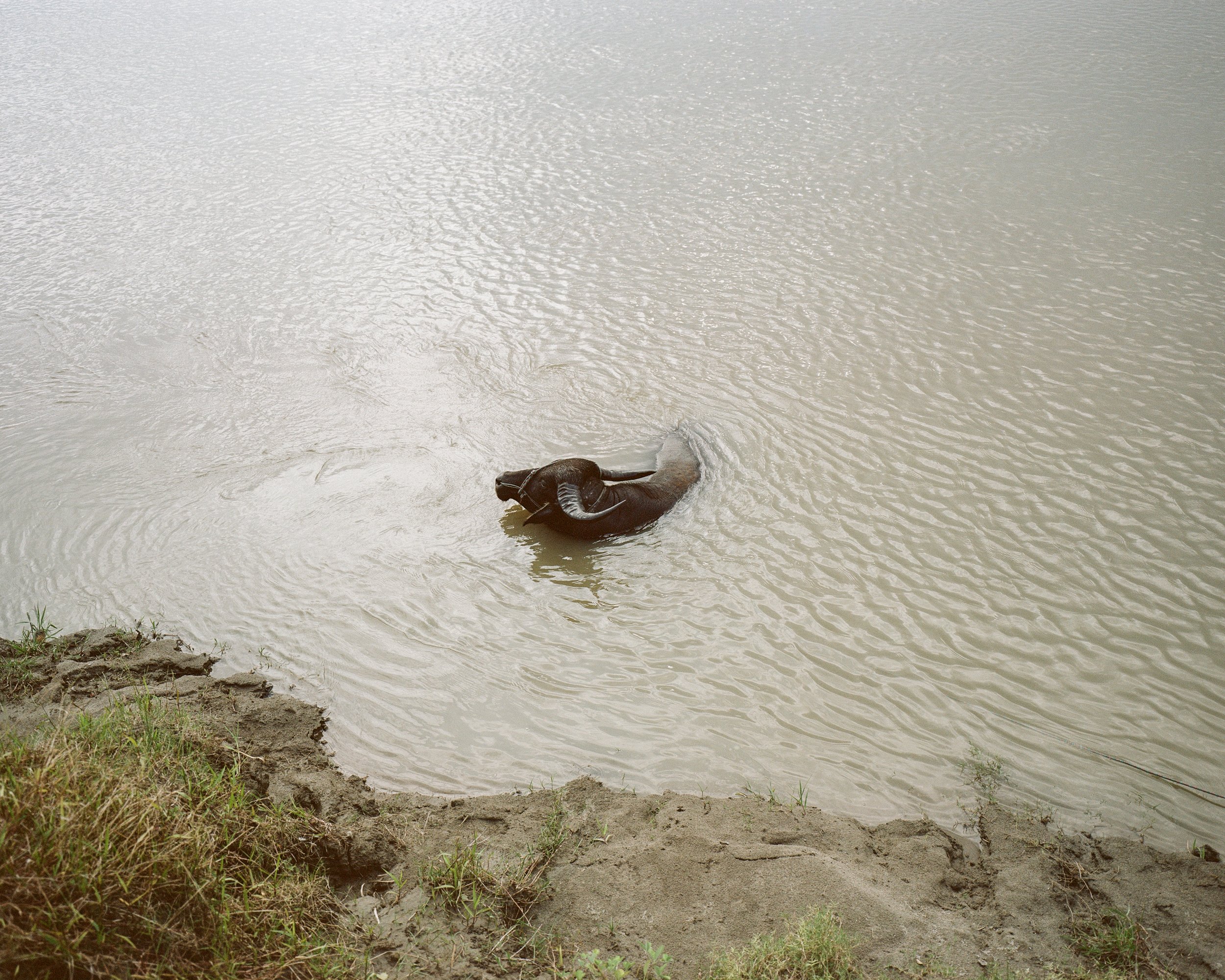
A water buffalo cools in the river Subansiri. Major Chapori, Majuli, India — 2021
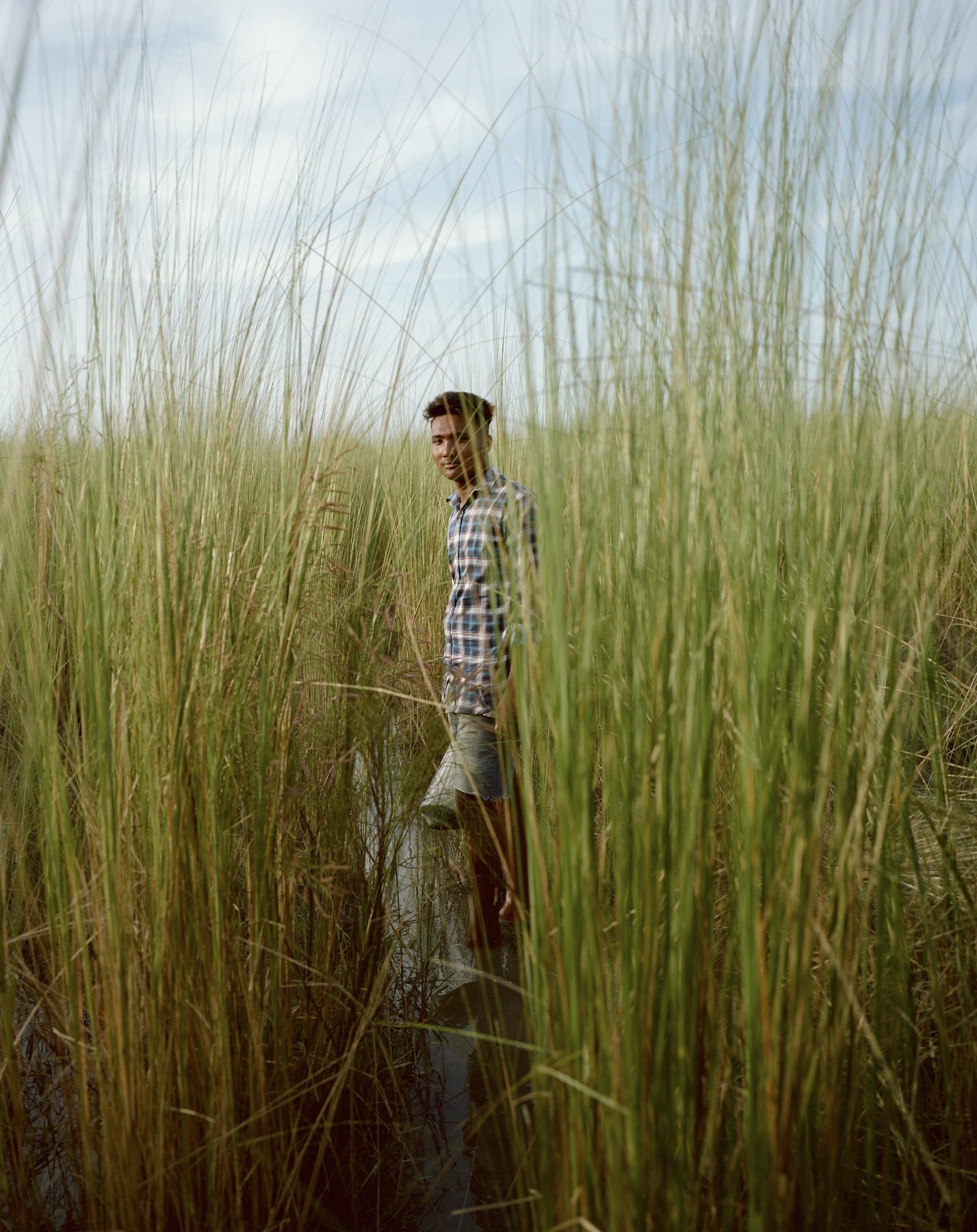
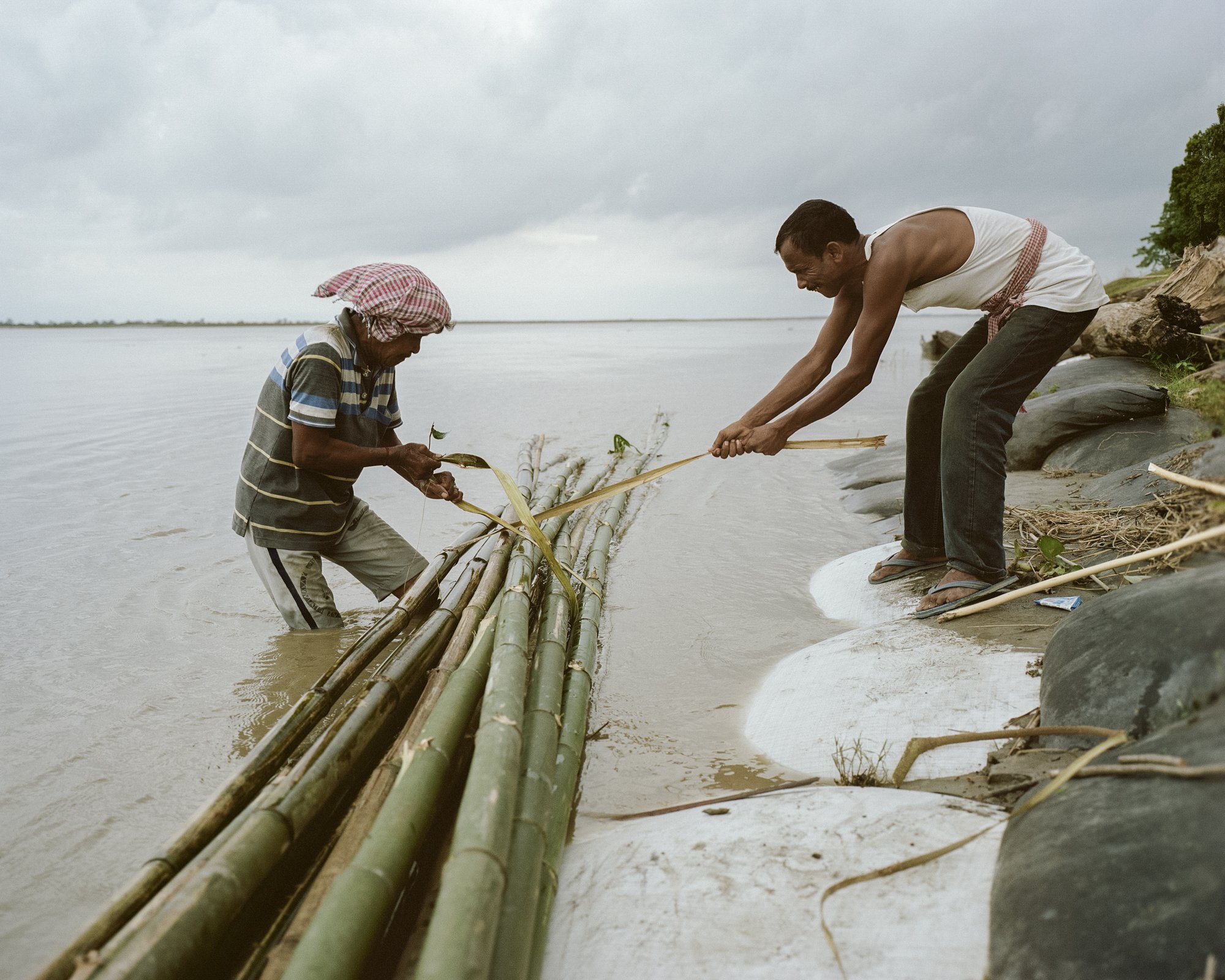
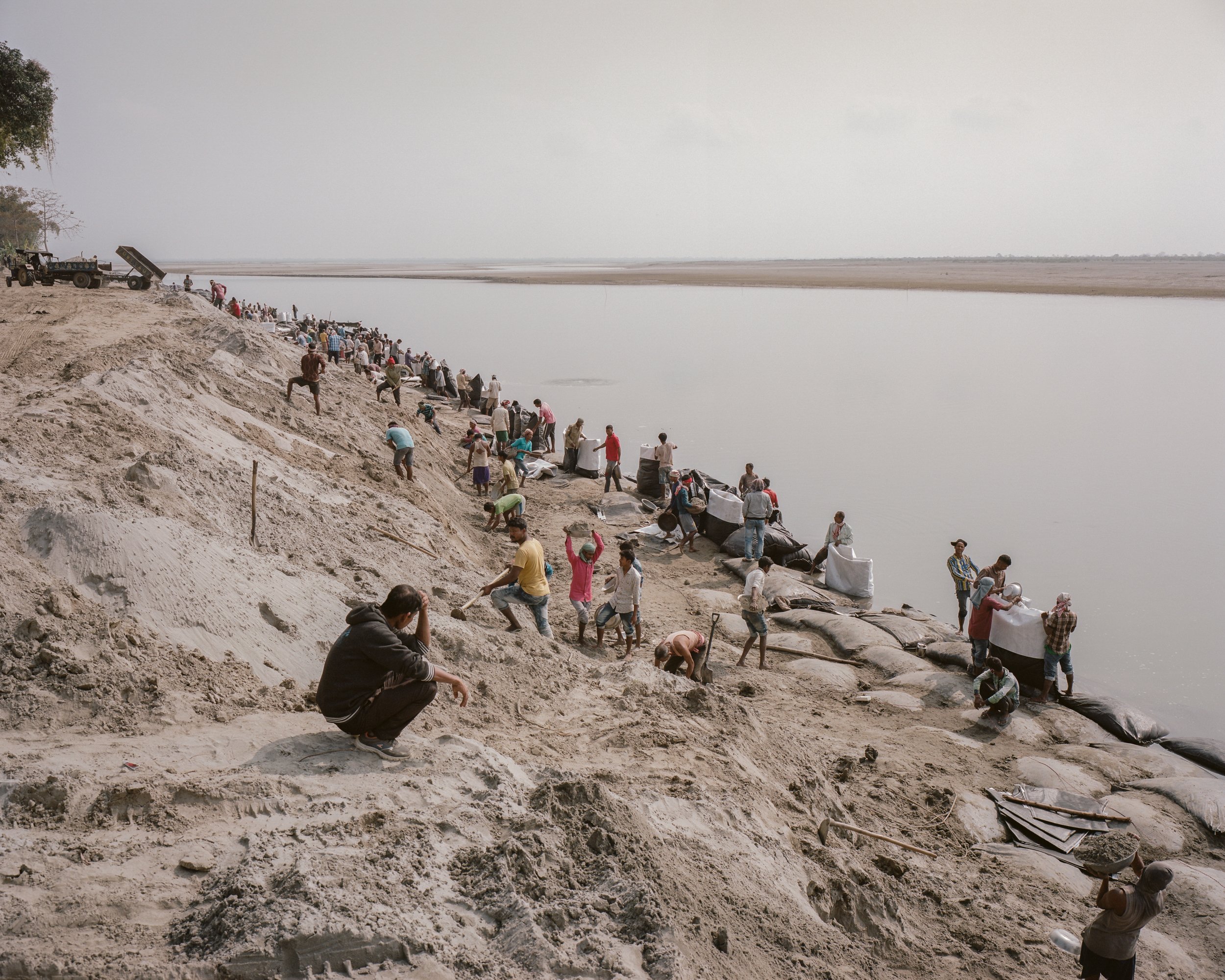
Villagers collect sand from the riverbed of Brahmaputra, and transport to endangered part of the riverside in order to build sandbag embankments.
Kumar Gaon, Majuli, India — 2020

The holy water is used for a wedding ritual where the mother washing and blessing the groom with the river water. People on the island are very close to the river spiritually.
Jengraimukh, Majuli, India, 2021
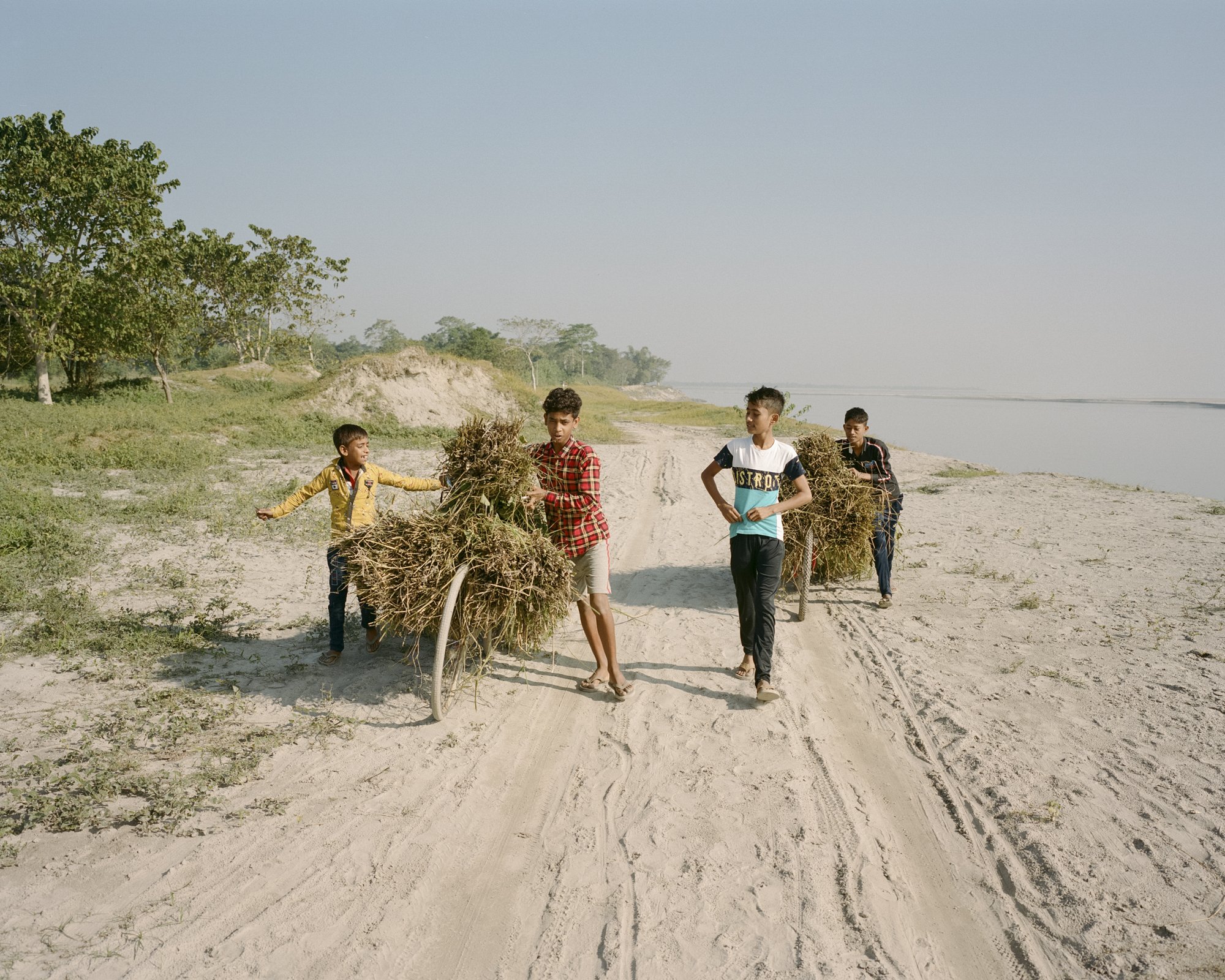
Gitartha Chamuah and her brothers carry home the straw needed to burn the clay, which was recently collected from the vegetation in the floodplain.
Salmora, Majuli, India — 2021
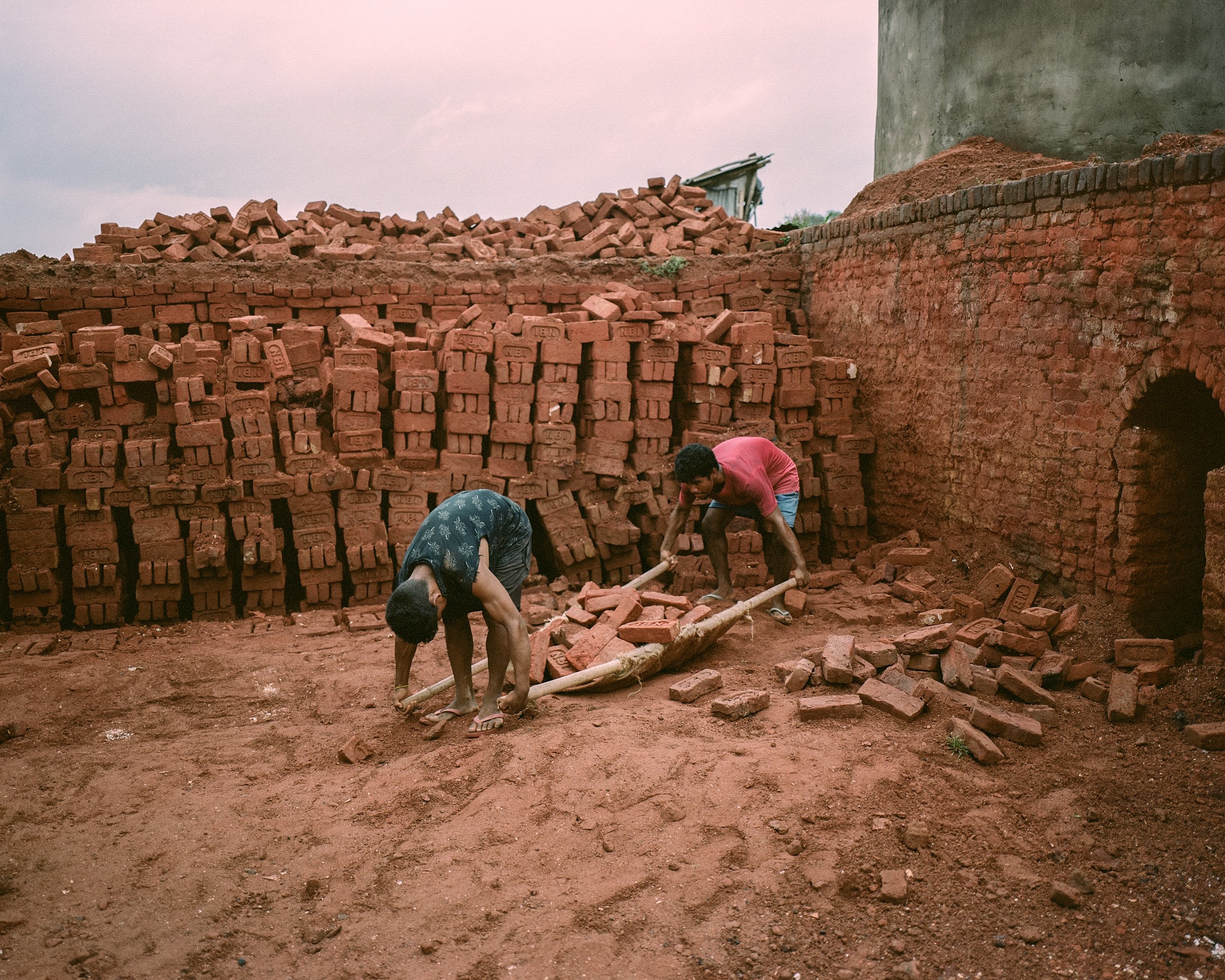
Brick factory
Nayabazar, Majuli, India — 2021
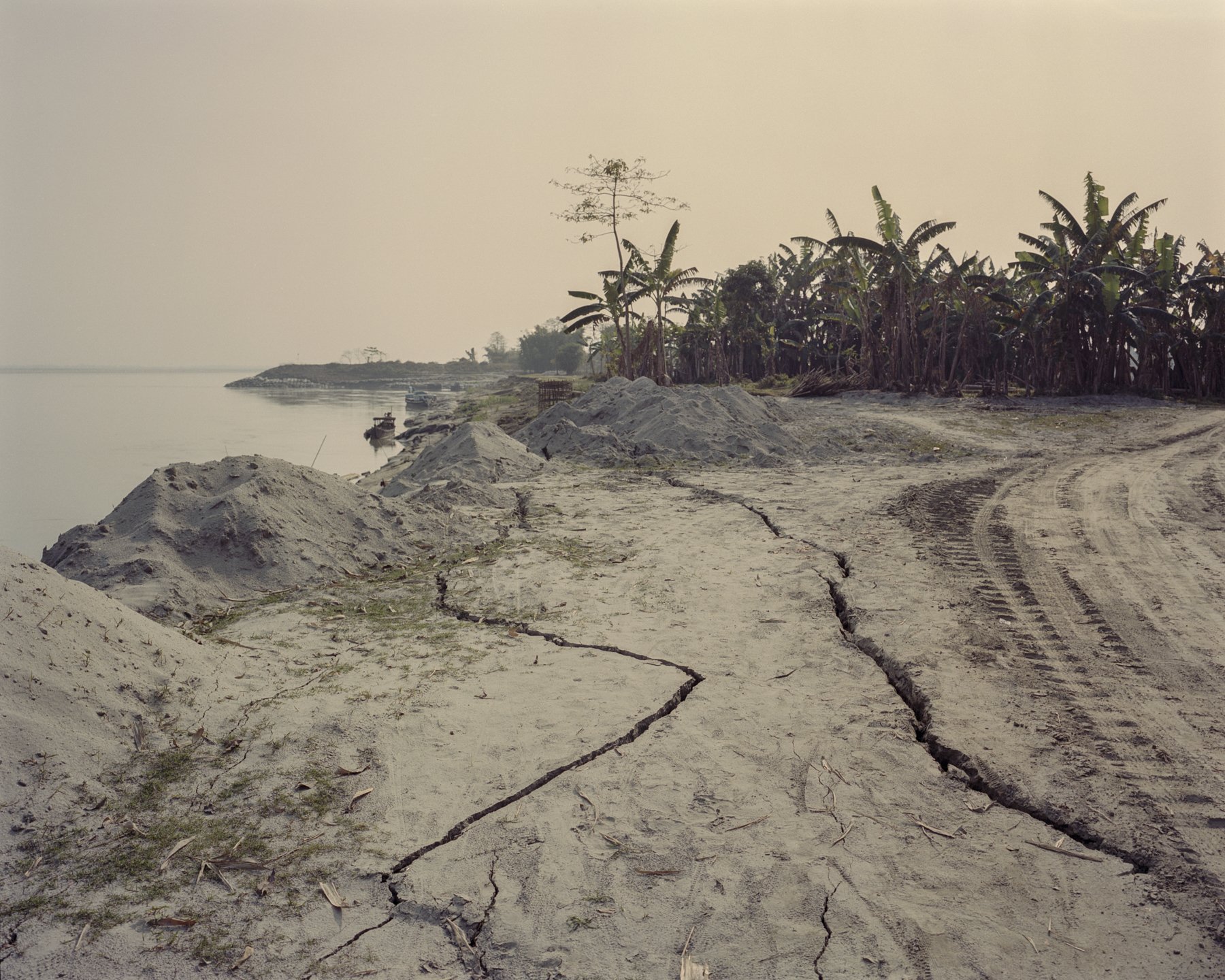
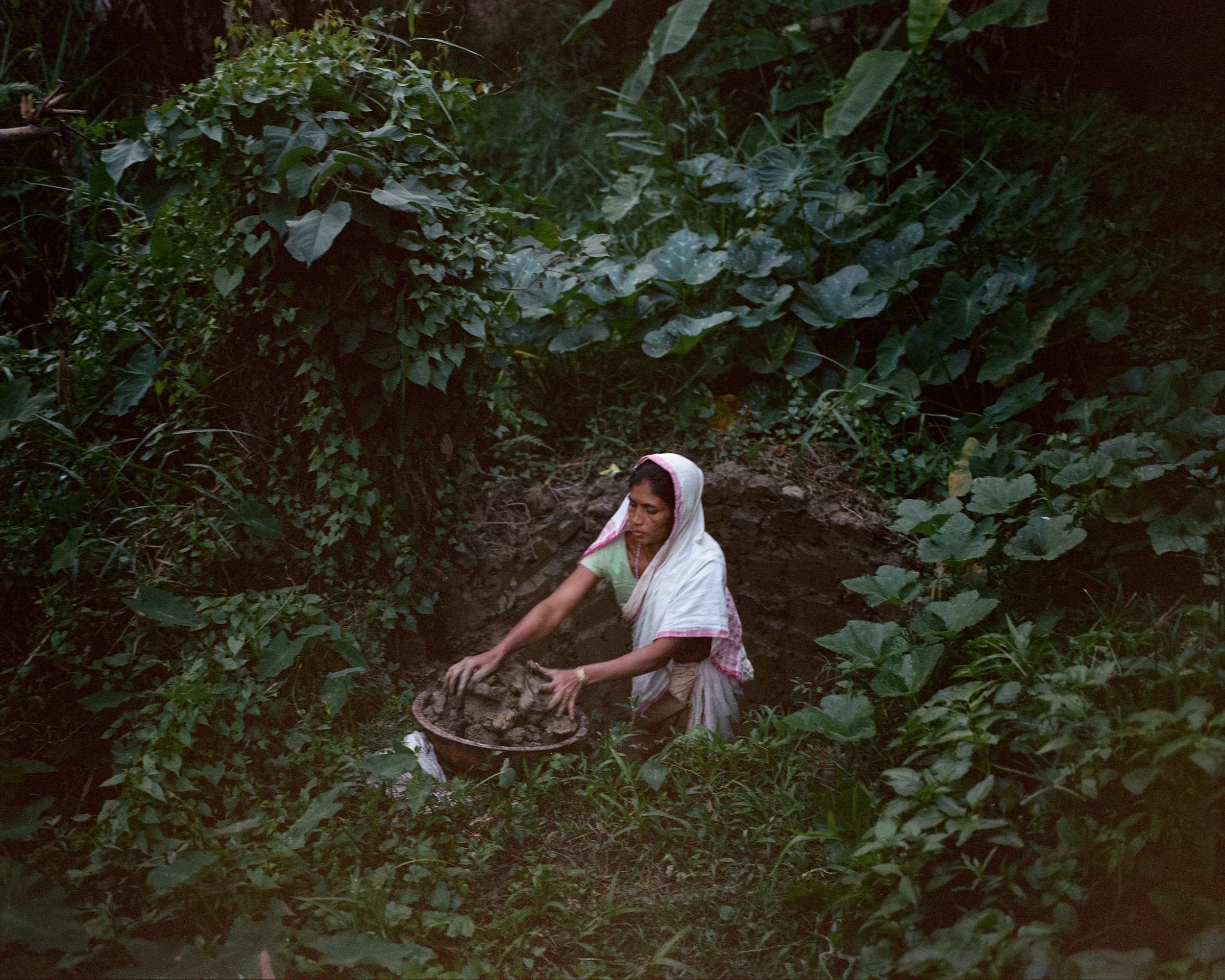
A clayey sediment deposited by Brahmaputra is dug by an Assamese woman from a pit near her house. According to centuries-old tradition, women here form hundreds of pots of fresh clay, which are burned and sold by male members of the family. Salmora is the village most exposed to the destruction of soil erosion. The existence of the families living here is directly influenced by the changing dynamics of the river, but they still want to stay close to the water as their ancestors.
Salmora, Majuli, India — 2021

Building new road
Jengraimukh, Majuli, 2021
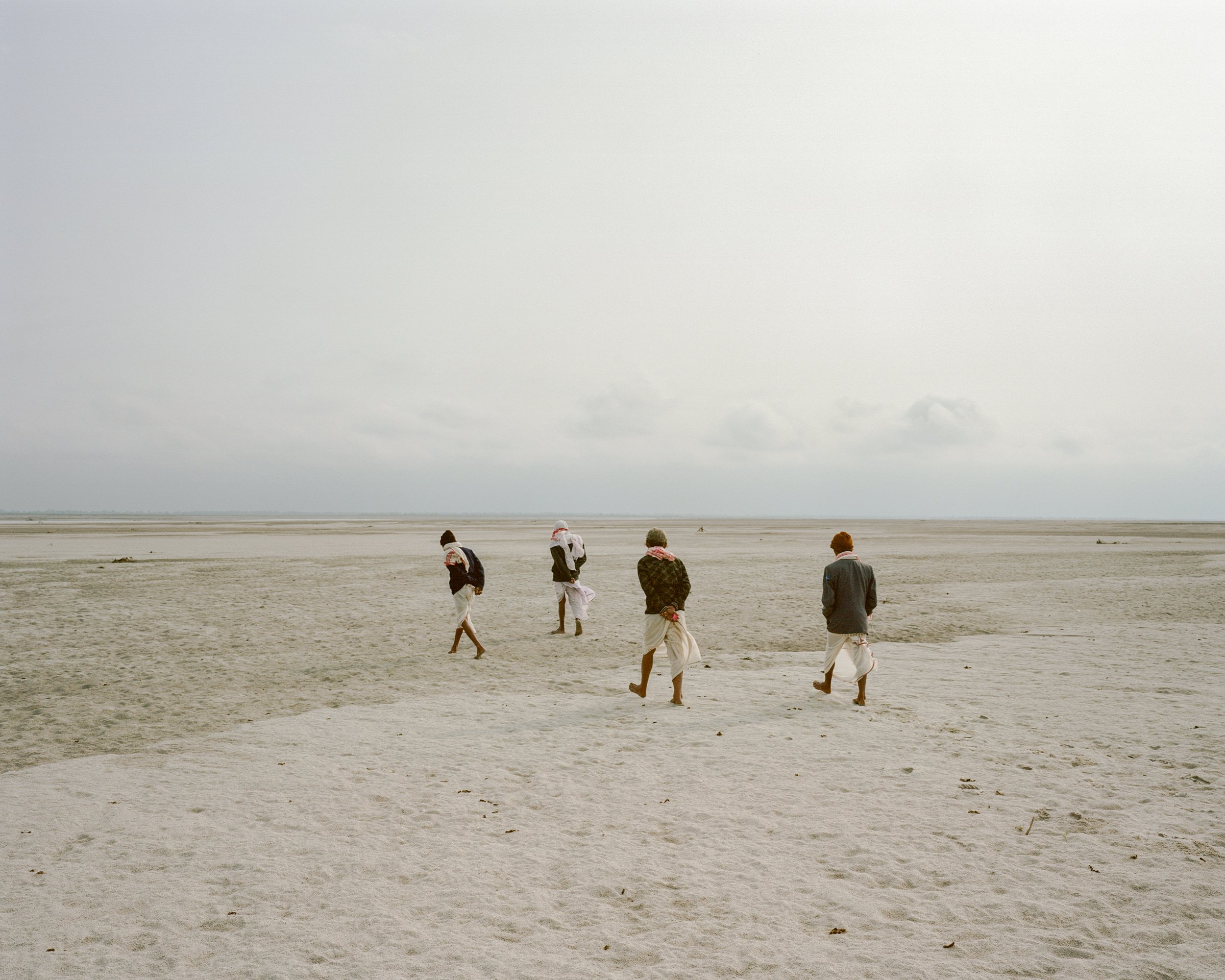
Elders walking on the riverbed of Brahmaputra after praying for gods of the river.
Salmora Chapori, Majuli, India — 2021
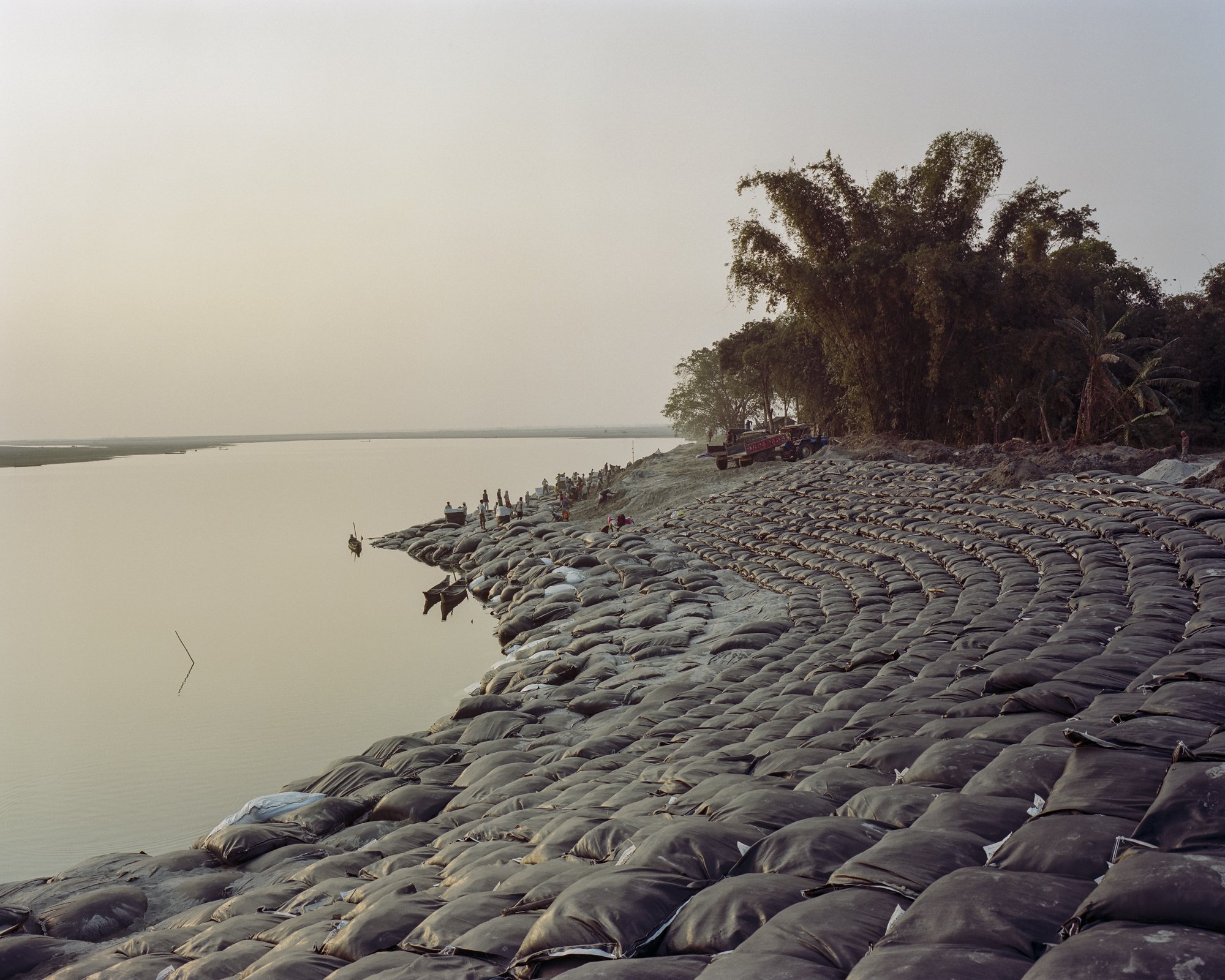
The flood comes and goes.
But the tears in my eyes don’t dry up. The pain remains.
/ folk song from Majuli /



































During my journey to India I met Brahmaputra, the son of God, the last great free- flowing river with a spirit and reverence.
In the eternal view of his floodplains, in the relentless flow of his stream, and in the people who respect and honour him, I was witness to a childhood memory I never got to know. All the missing elements from my childhood has been completed by the experiences I collected on the bank of this mighty river. ‘You can flood me, I’ll be here’ is an exploration of my encounter with a sensitive, harmonious, yet defenceless relationship of people with nature and water on the island of Majuli. My motivation is to photograph the issues of isolation in physical, social, and spiritual sense, and focusing on how people react to the river and interact with the ever-changing environment.
Men fish with a fenced trap called the ‚Jang’ on the Kherkata River, which is one of the inner branches of Brahmaputra and separates the island from the mainland on the north side. The families of the village come together and do the hard physical work and then share the fish from the net.
Jengraimukh, Majuli, India — 2020
Majuli is the largest river island in the world, located on the majestic Brahmaputra River that winds through the state of Assam in Northeast India. The history of the island and identity of people living there have been defined for centuries by the flooding presence of the river that actively shapes not only its territory, but fates. The sensitive, harmonious, yet defenseless relationship of people with nature and water manifests itself in dystopian everyday life. Their homes, safety of their families, crops and fished food, in fact, their simple existence, are all subject to the constant changes of the river and its environment. People have learned to live in balance and adapt to change over time. It has been accepted that the river is always lost or given. However, global environmental changes of our time have upset the balance: in the last few decades the island area has shrunk by a third due to increasing soil erosion forcing thousands of families to flee their homes, monsoons are no longer arriving at the usual time (or not at all), water pollution is increasing and floods have become more unpredictable.
Carefully stacked clay pots are patched with mud and straw and then fired all day long. Every little detail is significant: the fire laid out of the driftwood, the clay dug out of the riverbed and the construction of the dome are also a gesture towards nature.
Salmora, Majuli, India — 2021
I realized that the locals’ interpretation of the problem is completely different from what an outside observer might think at first. My main motivation and the reason why I am doing this project is to find a sensitive, unique narrative of climate change that does not dehumanize this issue by showing the sensational, but rather enhances the human aspect of the problem. I am interested in photographing the issues of Majuli’s isolation in physical, social, and spiritual sense, and fo- cusing on how families (I personally know) react to the river and interact with the ever-changing environment. Since 2020, I have visited the island 3 times so far, and would like to continue the story.
This is an ongoing project that has been supported by Carmencita—KODAK Grant, and the József Pécsi Photography Scholarship (Hungarian Cultural Fund).
Morning view of inland swamp lakes in Majuli between the two biggest village Gara- mur and Kamalabari. Humans and environment have been in dynamic relationship on the island for a long time ago. People adapted to the river’s annual rhythm, though, the ecological balance seems to be upset recently making flood-vulnerable lands
Kamalabari, Majuli, India — 2020
Traditionally built bamboo houses protect locals from rising water level during floods. The members of the indigenous tribes adapted to the extremely unpredictable river in this way.
Karatipar, Majuli, India — 2020
Islanders are accustomed to the constant presence of water, which determines their identity. As a significant part of the island is practically floodplain, roads and larger settlements were built on or along dams. Flooded lands are used differently each season.
Karatipar, Majuli, India — 2020
Rain is one of the most important forces shaping the island that locals see as a divine blessing and await the arrival of the monsoon to fill their paddy fields with water. However, the amount of precipitation also swells the Brahmaputra and makes it dangerous during summer.
Recently, the cycles of monsoon are no longer arriving at the usual pace which also makes cultivating more difficult. People must face and adapt somehow to irregular climatic changes.
Salmora is one of the most affected village all around Majuli. People are used to the constantly flooding river. When dangerous flood and erosion come, people give up their previous home and move forward, if it is possible. Since the island is shrinking, the less place left for those who need a new place to live. This house is built by government aid, however, the new owners has to be prepared for a possible move in the near future.
Salmora, Majuli, India — 2021
It had to wait longer than usual until the first heavy rainfall during last year’s monsoon. This climate anomaly has posed new types of challenges to farmers and livestock keepers. According to locals,, they have never experienced so little rainfall as they did this summer. The sudden blessing of heaven also surprised a flock of sheep who took refuge on the terrace of a school.
Takarchuk, Majuli, India — 2021
Farmers have to deal with drought through alternative methods. The annual crop should not be endangered, so in the absence of rain, they try to pump water on the freshly planted paddy field.
Kumar Bari, Majuli, India — 2021
Minol is a fisherman. He has been living on different chaporis from childhood. Chaporis are temporary sand islands that are shaped by sediments. Minol eve- ryday goes to fish and lives a simple life of river people. He is not willing to move away from the river.
Sumoi Mari Chapori, Majuli, India — 2021
Arima Das is cooking a festive lunch on a newly built sand island for his family and friends. After the morning fishing, they spend a full day together: praying for the abundance of fish to the gods of the river, eating rice, drinking tea and buffalo milk on the fine-grained sand in the Brahmaputra riverbed.
Salmora Chapori, Majuli, India — 2021
Fallen banana trees mark the trail of a new asphalt road near Phuloni. The new state president of Assam is implementing a huge infrastructure development on the island. The most significant of these is the nearly 5 km long bridge, which could completely change the island’s environment and current calm life.
Phuloni, Majuli, India — 2021
A Mising family holding a tribal ritual and collecting water from the river Kherkata which is a small offshoot of Brahmaputra. This narrow river flows west and south- west direction demarcating the northern boundary of Majuli. The holy water will be used for a wedding ritual where the mother will wash and bless the groom with the river water. People on the island are very close to the river spiritually.
Jengraimukh, Majuli, India — 2021
The only income during the monsoon season is to catch huge logs that can be sold later on. Villagers helping to pull out a hundreds of kgs piece from the Brahmaputra. After drying and chopping them they can sell for a decent price.
Ahato Guri, Majuli, India — 2021
A water buffalo cools in the river Subansiri. Major Chapori, Majuli, India — 2021
Villagers collect sand from the riverbed of Brahmaputra, and transport to endangered part of the riverside in order to build sandbag embankments.
Kumar Gaon, Majuli, India — 2020
The holy water is used for a wedding ritual where the mother washing and blessing the groom with the river water. People on the island are very close to the river spiritually.
Jengraimukh, Majuli, India, 2021
Gitartha Chamuah and her brothers carry home the straw needed to burn the clay, which was recently collected from the vegetation in the floodplain.
Salmora, Majuli, India — 2021
Brick factory
Nayabazar, Majuli, India — 2021
A clayey sediment deposited by Brahmaputra is dug by an Assamese woman from a pit near her house. According to centuries-old tradition, women here form hundreds of pots of fresh clay, which are burned and sold by male members of the family. Salmora is the village most exposed to the destruction of soil erosion. The existence of the families living here is directly influenced by the changing dynamics of the river, but they still want to stay close to the water as their ancestors.
Salmora, Majuli, India — 2021
Building new road
Jengraimukh, Majuli, 2021
Elders walking on the riverbed of Brahmaputra after praying for gods of the river.
Salmora Chapori, Majuli, India — 2021
The flood comes and goes.
But the tears in my eyes don’t dry up. The pain remains.
/ folk song from Majuli /